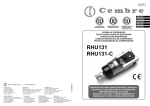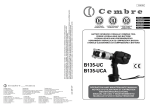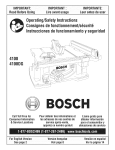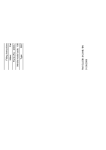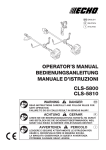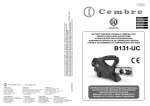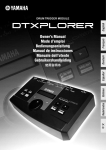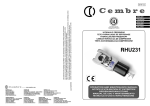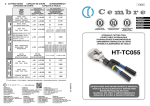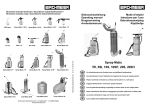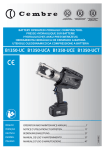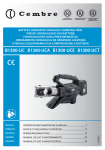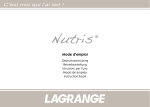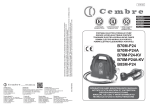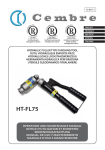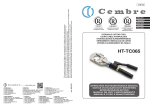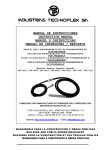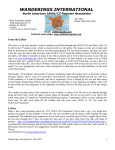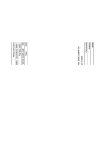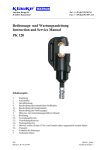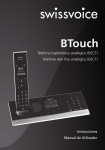Download HT131-U HT131-UC
Transcript
www.cembre.com Cembre S.p.A. Via Serenissima, 9 25135 Brescia (Italia) Telefono: 030 36921 Telefax: 030 3365766 E-mail: [email protected] www.cembre.it Cembre España S.L. Calle Verano, 6 y 8 - P.I. Las Monjas 28850 Torrejón de Ardoz - Madrid (España) Teléfono: 91 4852580 Telefax: 91 4852581 E-mail: [email protected] www.cembre.es Cembre Ltd. Dunton Park Kingsbury Road, Curdworth - Sutton Coldfield West Midlands B76 9EB (Great Britain) Tel.: 01675 470440 - Fax: 01675 470220 E-mail: [email protected] www.cembre.co.uk Cembre AS Fossnes Senter N-3160 Stokke (Norway) Phone: (47) 33361765 Telefax: (47) 33361766 E-mail: [email protected] www.cembre.no Cembre S.a.r.l. 22 Avenue Ferdinand de Lesseps 91420 Morangis (France) Tél.: 01 60 49 11 90 - Fax: 01 60 49 29 10 B.P. 37 - 91421 Morangis Cédex E-mail: [email protected] www.cembre.fr Cembre GmbH Heidemannstraße 166 80939 München (Deutschland) Telefon: 089/3580676 Telefax: 089/35806777 E-mail: [email protected] www.cembre.de cod. 6261070 This manual is the property of Cembre: any reproduction is forbidden without written permission. Ce manuel est la proprieté de Cembre: toute reproduction est interdite sauf autorisation écrite. Der Firma Cembrebleibt das Eigentumsrecht der Bedienungsanleitung vorbehalten. Ohne vorherige schriftliche Genehmigung darf die Bedienungsanleitung weder vollständig noch teilweise vervielfältigt werden. Este manual es propiedad de Cembre. Toda reproducción está prohibida sin autorización escrita. Questo manuale è di proprietà della Cembre: ogni riproduzione é vietata se non autorizzata per scritto. 05 M 057 Cembre Inc. Raritan Center Business Park 181 Fieldcrest Avenue Edison, New Jersey 08837 (USA) Tel.: (732) 225-7415 - Fax: (732) 225-7414 E-mail: [email protected] www.cembreinc.com ENGLISH FRANÇAIS DEUTSCH ESPAÑOL Certified Quality Management System Certified Environmental Management System Certified Occupational Health & Safety Management System ITALIANO HYDRAULIC CRIMPING TOOLS PRESSES HYDRAULIQUES HYDRAULISCHE PRESSWERKZEUGE HERRAMIENTAS HIDRAULICAS DE COMPRESION UTENSILI OLEODINAMICI DA COMPRESSIONE HT131-U HT131-UC OPERATION AND MAINTENANCE MANUAL NOTICE D'UTILISATION ET ENTRETIEN BEDIENUNGSANLEITUNG MANUAL DE USO Y MANTENIMIENTO MANUALE D'USO E MANUTENZIONE FORCE TYPE 1 130 kN HT131-UC Made in Italy 2 1 2 3 - Tool type Outil type Handwerkzeug Typ Herramienta tipo Tipo di utensile 2 – – – – – When operating the tool keep hands away from the danger zone. Au cours du sertissage, tenir les mains éloignées de la zone de danger. Während des Verpressens nicht mit den Händen in den Pressbereich langen. Durante su utilización, mantenga las manos fuera de la zona de peligro. Durante l'utilizzo, mantenere le mani fuori dalla zona di pericolo. – – – – – Do not pump when dies are not in place. Insérer les matrices avant d'actionner l'outil. Nicht ohne Presseinsatzpaar betatigen. No poner en presión sin matrices. Non mandare in pressione l'utensile senza le matrici inserite. Force Force Kraft Fuerza Forza Year Année Jahr Año Anno 3 1 42 AC 130-P PS 130-150/E PS 130-95/E PS 130-35/E Indentor Poinçon Stempel Punzón Punzone UP130-300 UP 130-240 PS 130-240/E UP 130-185 UP 130-150 UP 130-120 UP 130-95 UP 130-70 UP 130-50 UP 130-35 UP 130-25 Pre-rounding die Lower adaptor Adaptateur inferieur Matr. de mise au rond Ründdrückeinsätze Halter Preredondeador Adaptador inferior Adattatore inferiore Prearrotondatore = 34mm = 34mm Verbinder Aussendurchmesser = 34mm Diametro externo conector = 34mm Diametro esterno connettore = 34mm diameter of connector * Outside Diametre exterieur connecteur AU 130-240 AU 130-150 Upper adaptor Conductor section Section conducteur Adaptateur superieur Werkzeughalter Leiter Querschnitt Adaptador superior Sección cable Adattatore superiore Sezione cavo MVC 240 MTMA... MTA... AA...M MUA 240 MUA 150 MUA 95 MUA 35 Universal - Universelles Universal -Universale Universale CONNECTORS - CONNECTEURS - VERBINDER - CONECTORES - CONNETTORI CAA..-M MTA..-C MVM 240 MV 240 MVC 150 MVC 95 MUA 300-34 MVM 150 MVM 95 MVM 35 Long - Longue - Lang - Larga -Lunga MV 150 MV 95 MV 35 Kurz - Corta - Corta Short - Courte - Containing die - Matrice coquille - Presseinsatzschale Matrice de sujección - Matrice di contenimento GUIDE TO THE SELECTION OF ACCESSORIES - GUIDE POUR LA SELECTION DES ACCESSOIRES - ZUBEHÖR FÜR DIE TIEFNUTKERBUNG - GUIA PARA LA ELECCIÓN DE ACCESORIOS GUIDA PER LA SCELTA DEGLI ACCESSORI 4 10 - 16 25 35 50 70 95 120 150 185 240 300 * Before using the tool, carefully read the instructions in this manual. Avant d'utiliser cet outil, lire attentivement les instructions de cette notice. Vor Inbetriebnahme unbedingt die Bedienungsanleitung durchlesen. Antes de utilizar la herramienta, leer atentamente las instrucciones contenidas en este manual. Prima di utilizzare l'utensile, leggere attentamente le istruzioni contenute in questo manuale. 4 3 Aluminium Aluminio Alluminio 1 – – – – – 3 2 ( mm2 ) 1 FIG. 9 TG. 0356 ! ▲ WARNING LABELS - ETIQUETTES SIGNALETIQUES - WARNSCHILDER ETIQUETAS DE ATENCION - ETICHETTE D'AVVERTENZA ENGLISH HYDRAULIC CRIMPING TOOLS HT131-U and HT131-UC * 32 31 30 33 29 35 28 27 37 38 E 24 23 22 21 20 19 76 77 78 79 68 67 66 80 40 41 E 42 44 16 15 14 46 (14.6 sh ton) – Rated operating pressure: ....................................................... 700 bar (10,000 psi) 45 47 – Weight (without dies): ................................................................ 5,4 kg 48 (11.9 lbs) 50 or or equivalent 49 – Recommended oil: ................................ AGIP ARNICA 22 ESSO INVAROL EP22 51 Serial number 52 Numéro de série – Operating positions. The three operating positions are identified on the main handle, which rotates relative to the reference symbol, (see Fig. 1). 53 Seriennummer 12 11 10 65 64 09 63 08 07 62 54 57 56 Rest position (Handles locked): lock handles together when tool is not in use. Número de serie Numero di matricola 06 61 60 – Crimping force: ......................................................................... 130 kN – Dimensions: length ................................................................... 488 mm (19.2 in.) width with handles closed .................................... 149 mm (5.8 in.) width with handles open ....................................... 349 mm (13.7 in.) 43 18 17 13 81 39 ➛ 70 71 72 73 74 75 – Application range: is suitable both for compression of electrical connectors on conductors up to 400 mm2 (800 MCM) and aluminium conductors up to 300 mm2 (600 MCM) . 36 26 25 69 1. GENERAL CHARACTERISTICS 34 E-E 05 Release position: close the moveable handle (53) against the main handle (04), in order to discharge the oil pressure and retract the dies. 04 59 Operating position: operate the moveable handle (53), to build up pressure and close the dies. 03 55 02 58 01 FIG. 8 – Advancing speed. The tool has two forward speeds of the ram and automatically switches from a fast advancing speed of dies to a slower crimping speed. – Safety. The tool is provided with max pressure valve; MPC1 special manometer, is available upon request to check the correct setting of the valve. LONGITUDINAL SECTION COUPE LONGITUDINALE SCHNITTZEICHNUNG SECCIÓN LONGITUDINAL SEZIONE LONGITUDINALE * 41 The HT131-UC tool is the HT131-U tool fitted with adaptor AU130-C. (Ref. to Fig. 2). 2 ENGLISH 2. APPLICATION RANGE 2.1) The tool HT131-UC is supplied with the AU130-C adaptor, which will accept the semi- VAL130 circular slotted dies (common to Cembre 130 kN tooling) suitable for: – Indentation on copper conductors – Circular Compression on copper conductors. – Hexagonal compression on copper, aldrey or aluminium conductors. 2.2) With the upper adaptor AU130-... and lower adaptor AC130-P, the tool HT131-U or HT131-UC can accept: – Pre-rounding dies UP 130-... (used for converting aluminium sectoral conductor to a compact, round section). – Containing dies (MV, MVC, MVM, MUA series) and the relevant Indentors PS130-.../E (to crimp connectors on aluminium cables using the deep indent crimping system). VALP3 FIG. 6 STORAGE CASE - RANGEMENT - LAGERUNG - ALMACENAMIENTO - CUSTODIA 3. INSTRUCTIONS FOR USE (Ref. to Fig. 1, 2 and 3) Instruction for use are referring to the tool featuring an AU130-C adaptor but they are completely suitable also for tool equiped with AU130-... and AC130-P adaptors (regardless of selected dies). 01 3.1) Setting With the tool is in rest position operate as follows: – Select the appropriate die set for the connector. – Insert the die set (88 and 89) into the head, as § 4.3. – Insert the conductor in the connector. – Position the connector between the dies and ensure the correct location of the crimp. 70 53 3.2) Die advancement 62 – Set the tool on release position by rotating main handle (04); open the moveable handle (53). – Rotate main handle (04) to operating position . – Operate moveable handle (56) for lower die advancement. This first stage rapidly closes the dies to the connector. ! ▲ NEVER PRESSURIZE THE TOOL WITHOUT INSERTING THE DIES AS THIS COULD CAUSE DAMAGE TO THE TOOL HEAD AND THE RAM. Make sure the dies are exactly positioned on desired crimp point, otherwise re-open dies following instructions as per § 3.4 and position the connector again. 3 03 04 28 FIG. 7 TOOL POSITION FOR MAINTENANCE OPERATIONS - POSITION DE L'OUTIL POUR L'ENTRETIEN WERKZEUG WARTUNGSPOSITION - COLOCACION PARA LAS OPERACIONES DE MANTENIMIENTO - POSIZIONAMENTO PER LE OPERAZIONI DI MANUTENZIONE 40 ENGLISH FIG. 4 ACCESSORIES ACCESSOIRES ZUBEHÖR ACCESORIOS ACCESSORI 3.3) Crimping AU130-... Adaptor Adaptateur AU130-... Adapter AU130-... Adaptador AU130-... Adattatore AU130-... Die Matrice Matrize Matriz Matrice Rounding set Matrice de Runddrück Set mise au rond Preredondeador Prearrotondatore – Continue operating the moveable handle (53). The tool will automatically change over to the high pressure stage. The ram will advance until the dies meet. – It is recommended to continue pumping until the maximum pressure valve is activated and a "click" is heard. 3.4) Dies re-opening – Rotate main handle to release position . Completely close handles and the die will retract. 3.5) Rest setting Indentor Poinçon Stempel Punzón Punzone AC130-P Adaptor Adaptateur AC130-P Adapter AC130-P Adaptador AC130-P Adattatore AC130-P – Completely retract the ram as § 3.4. – Close handles and rotate main handle to rest position will be locked. – Store the tool in the plastic case. ; the moveable handle 4. CRIMPING OF CONNECTORS ON COPPER CABLES (Ref. to Fig. 2 and 3) 33 4.1) Connector crimping 33 34 98 32 34 98 32 30 30 28 91 28 95 – – – – – – Fit adaptor AU130-C (see § 4.2). Select the appropriate die set for the connector. Insert die set in to upper and lower die holders (see § 4.3). Insert the conductor in the connector. Position the connector between the dies and ensure the correct location of the crimp. To crimp connector continue as § 3.2. 4.2) Adaptor assembly Insert the AU130-C (90) adaptor in the guides on the U-fork (33) until securely located, with the grooves on the adaptor corresponding to the locators (34) on the U-fork head (33). Remove the adaptor by pushing the adaptor off the locators and sliding from the head. 4.3) Dies assembly 4.3.1) Press release button (86) and insert the upper die (88) into the AU130-C adaptor (90) until secured by the die retaining pin (87). To remove the upper die, press the release button (86) and slide the die from the adaptor (90). 96 28 92 94 93 4.3.2) Press the release pin (30) and insert the lower die (89) into the seat on the ram (28) until secured by the pin (32). To facilitate this operation an advancement of 3-4 mm (0.12 - 0.16 in.) of the ram (28) is suggested. To remove the die press the release pin (30) and slide the die from the ram. FIG. 5 DIES REPLACEMENT / INSERTION DES MATRICES / EINRASTEN PRESSEINSATZE INSERCIONDE LAS MATRICES / INSERIMENTO MATRICI 39 4 ENGLISH 5. CRIMPING OF CONNECTORS ON ALUMINIUM CABLES (Ref. to Fig. 4 and 5) 5.1) Pre-rounding conductor (for sectoral cables) – From the table (Fig. 9, page 42) select the adaptors and pre-rounding dies for the appropriate conductor size. – Insert the upper adaptor AU130-... and AC130-P lower adaptor into the head (see § 5.3). – Insert the pre-rounding die (94) into the AC130-P adaptor (see § 5.4). – Position the conductor into the pre-rounding die (95) and locate the pre-rounding die (95) in the adaptor AU130-... (see § 5.4). Ensure that the pre-rounding die is correctly located in the adapter with it’s upper slot in line with the internal adapter pins. – Operate the tool until the dies are fully closed. Release the hydraulic pressure (see § 3.4) and remove the compacted round conductor. – Remove the pre-rounding dies and the adaptor AC130-P from the tool head (see § 5.4). – From the table (Fig. 9, page 42) select the containing die and indentor recommended for the conductor size. – Insert the indentor PS130.../E into the ram (28) (see § 5.4). – Insert conductor into the connector; locate the connector into the containing die; locate the containing die in the adaptor (see § 5.4). Commence indent crimping from the barrel end for both splices and terminals, following the sequence shown below. – For every operation ensure the die is correctly located in the adapter with it’s upper slots in line with the internal adapter pins. – Each indenting operation is completed when indentor and die are fully closed; it is recommended to continue pumping until the maximum pressure valve is activated and a "click" is heard. (see § 3.3). INDENTING SEQUENCE 1 2 1 4 3 2 Adaptateur AU130-C Adapter AU130-C Adaptador AU130-C Adattatore AU130-C Nest and Indent dies Matrice et Poinçon Matrize und Stempel Matriz y punzón Matrice e punzone Circular dies Matrices circulaires Rund PresseMatrices Matrici insätze semicirculares semicircolari Hexagonal dies Matrices Sechskant Matrices hexagonales Presseinsätze hexagonales 33 ~ 3 - 4 mm (0.12 - 0.16 in.) 5.2) Connector crimping FIG. 2 ACCESSORIES ACCESSOIRES ZUBEHÖR ACCESORIOS ACCESSORI AU130-C Adaptor 90 32 88 30 ➛ ➛ FIG. 3 – Insert the upper adaptor AU130-... (98) into the U-fork head (33) until secured by the locators (34). To remove the adaptor from the U-fork head, push the adaptor from the locators and slide out. 5 86 34 28 5.3) Adaptor fitting and removal 87 Matrici esagonali DIE REPLACEMENT INSERTION DES MATRICES EINRASTEN PRESSEINSÄTZE INSERCION DE LAS MATRICES INSERIMENTO MATRICI 38 89 ENGLISH - Reference symbol - Repère fixe - Reference ideogram - Simbolo de referencia - Simbolo di riferimento 33 34 28 13 70 – To insert the adaptor AC130-P (91), press the die release pin (30). Insert the adaptor into the seat of the ram (28), until secured by the retaining pin (32). To facilitate this operation, an advancement of 3 ÷ 4 mm (0.12 - 0.16 in.) of the ram (28) is suggested. To remove the adaptor, press the die release pin (30) and slide the adaptor from the ram (28). 5.4) Dies, indentors, pre-rounding dies - fitting and removal (Ref. to Fig. 5) – The containing die (96) and upper pre-rounding die (95): are located in the adaptor AU130-... (98) by grooves in the upper face. – The lower pre-rounding die (94): is inserted or removed from the adaptor AC130-P (91), by pulling the release button (92). – The indentor PS130.../E (93): is inserted into the seat on the ram (28) (see § 4.3.2). 6. WARNING The tool is robust and requires very little daily maintenance. Compliance with the following points, should help to maintain the optimum performance of the tool. 6.1) Accurate cleaning LOCK Dust, sand and dirt are a danger for any hydraulic device. Every day, after use, the tool must be cleaned with a clean cloth, taking care to remove any residual, especially close to pivots and moveable parts. 51 - Rest position - Release position - Operating position - Repère de repos - Repère de décompression - Repère de travail - Ruhestellungs - Druckablass position position - Arbeits position - Posición de reposo - Posición de liberación - Posición de trabajo - Posizione di riposo - Posizione di rilascio - Posizione di lavoro 53 04 6.2) Storage (Ref. to Fig. 6) When not in use, thetool should be stored and transported in it's case to prevent damage. Following cases are available: – VALP3 plastic case: size 620x380x135 mm (24.4x14.9x5.3 in.), weight 2,5 kg (5.5 lbs). – VAL130 steel case: size 360x280x48 mm (14.17x11x1.89 in.), weight 3 kg (6.62 lbs), for storage of the accessories for crimping aluminium connectors. 6.3) Head rotation For ease of operation, the tool head can rotate through 180°. Warning: do not attempt to turn the head if the hydraulic circuit is pressurised. 7. MAINTENANCE (Ref. to Fig. 7 and 8) FIG. 1 OVERALL VIEW VUE D'ENSEMBLE GLOBALANSICHT VISTA DEL CONJUNTO VISTA D'ASSIEME Air in the hydraulic circuit may affect the performance of the tool; e.g. no lower die advancement, slow advancement of the lower die; lower die pulsating. In this case proceed as follows: 37 6 ITALIANO ENGLISH 9. LISTA DEI COMPONENTI (Rif. a Fig. 8) a – Hold tool upright in a vice with handles open (Fig. 7). b – By an hexagonal 2,5 mm key, remove screw (62) and main handle (04) to expose oil reservoir (03). c – Remove reservoir cap (01). d – Operate three or four times the moveable handle (53), to advance the ram (28). e – Depress pressure release pin (70) until ram is fully retracted. f – Repeat points (d - e) at least five times, to ensure all air bubbles in the hydraulic circuit are purged into the reservoir. g – If the oil level is low, top up as directed in § 7.2. h – Remove all air from reservoir and fit cap (01). i – Assemble main handle (04), and holding screw (62). If the tool continues to malfunction return the tool for service/repair as detailed in § 8. 7.2) Oil top up Every six months check the oil level in the reservoir. If necessary, top up the oil level to the top lip of the reservoir and remove all air from the reservoir, see 7.1, points a, b, c, e, g, h and i. Always use clean recommended oil, see § 1. Do not use old or recycled oil. Do not use hydraulic brake fluid. ! ▲ Ensure that disposal of used oil is in accordance with current legislation. 8. RETURN TO Cembre FOR OVERHAUL In the case of a breakdown contact our Area Agent who will advise you on the problem and give you the necessary instructions on how to dispatch the tool to our nearest service Centre; if possible, attach a copy of the Test Certificate supplied by Cembre together with the tool or, if no other references are available, indicate the approximate purchase date and the tool serial number. N° Codice Part. DENOMINAZIONE 6800040 01 TAPPO SERBATOIO 6380265 ● 02 IMPUGNATURA MANICO FISSO 6720100 03 SERBATOIO 6480043 ● 04 MANICO FISSO 6760014 ● 05 SPINA ELASTICA ø 3x4 6780105 ● 06 SUPPORTO MANICO FISSO 6360260 ★ 07 GUARNIZIONE OR 6040685 08 ANELLO GUIDA 6900621 09 VITE ASPIRAZIONE COMPL. 6360160 ★ 10 GUARNIZIONE OR 6740060 ★ 11 SFERA 3/16" 6520765 ★ 12 MOLLA ASPIRAZIONE 6160234 13 CORPO 6740060 ★ 14 SFERA 3/16" 6520765 ★ 15 MOLLA ASPIRAZIONE 6740140 ★ 16 SFERA 9/32" 6520180 ★ 17 MOLLA ANTIRITORNO 6340566 18 GRANO TENUTA SFERA 6900059 19 VITE M 4x8 6100020 20 CHIAVETTA 6700250 ▲ 21 ANELLO ELASTICO ø 36 6170140 ▲ 22 COPERCHIO MOLLA 6360420 ★ ▲ 23 GUARNIZIONE OR 6040320 ★ ▲ 24 ANELLO BK 6520620 ▲ 25 MOLLA ESTERNA RICH. PISTONE 6520610 ▲ 26 MOLLA INTERNA RICH. PISTONE 6300040 ▲ 27 FUNGO 6620315 ▲ 28 PISTONE 6522006 ▲ 29 MOLLA PISTONCINO 6620445 ▲ 30 PIST.SBLOCCA MATR./PIST. 6760040 ▲ 31 SPINA ELASTICA Ø 3x8 6620320 ▲ 32 PIST. FERMA MATR./PIST. 6280025 ■ 33 FORCELLA 6340630 ■ 34 GRANO CON SFERA M10 6180800 ■ 35 DADO M10 6100035 36 CHIAVETTA 6900252 37 VITE M 5x14 6362035 ★ 38 GUARNIZIONE PIENA 6362010 ★ 39 GUARNIZIONE R6 6641140 ★ 40 ANELLO BK - R6 6360240 ★ 41 GUARNIZIONE OR 6362020 ★ 42 GUARNIZIONE JF 6620382 43 PISTONE POMPANTE Q.tà 1 1 1 1 1 1 1 2 1 1 1 1 1 1 1 1 1 1 1 1 1 1 1 1 1 1 1 1 1 1 1 1 1 2 2 1 1 1 1 1 1 1 1 I particolari indicati con (★) sono quelli che la Cembre consiglia di cambiare sempre nel caso di un eventuale smontaggio dell'utensile. Detti particolari sono fornibili su richiesta nella “Confezione Ricambio per HT131-U“. 7 36 N° Codice Part. 6760320 6780265 6700100 6700100 6080060 6560420 6560420 6200030 6760280 6480269 6380240 6232006 6650118 6232068 6760040 6740020 6520280 6640205 6900060 6895050 6360160 6740120 6600100 6520260 6740080 6340540 6620120 6360120 6040060 6080080 6900280 6180200 6340566 6520180 6740140 6635011 6520861 6340720 6480042 6620316 6280026 6480194 6000074 ✚ ✚ ★ ✚ ✚ ✚ 44 45 46 47 48 49 50 ✚ 51 ✚ 52 ✚ 53 ✚ 54 55 56 57 ▲ 58 ★ 59 60 61 62 63 ★ 64 ★ 65 66 67 ★ 68 69 70 ★ 71 ★ 72 73 ✚ 74 ✚ 75 76 ★ 77 ★ 78 79 80 81 ● ▲ ■ ✚ ★ DENOMINAZIONE Q.tà SPINA ELASTICA ø 5x30 1 SUPPORTO MANICO MOB. 1 ANELLO ELASTICO D. 7 2 ANELLO ELASTICO D. 7 2 BUSSOLA MANICO MOBILE 4 PERNO MANICO MOBILE 01 PERNO MANICO MOBILE 1 DENTE ARRESTO MANICO MOB. 1 SPINA ELASTICA ø 4x30 1 MANICO MOBILE 1 IMPUGNATURA MANICO MOBILE 1 ETICHETTA (TG. 0356) 1 RIVETTO ø 2,5 x 3,5 2 TARGHETTA (TG. 0268) 1 SPINA ELASTICA ø 3x8 1 SFERA 1/4" 1 MOLLA 1 RONDELLA DENTATA 1 VITE M 4x8 1 VALVOLA COMPLETA 1 GUARNIZIONE OR 1 SFERA 7/32" 1 NOTTOLINO SPINGI SFERA 1 MOLLA SCARICO 1 SFERA 5/16" 1 GRANO M 10x8 1 PIST. SBLOCCA PRESSIONE 1 GUARNIZIONE OR 1 ANELLO BK 1 BUSSOLA PIST.RIT.PRESS. 1 VITE M 5x18 1 DADO M5 1 GRANO TENUTA SFERA 1 MOLLA ANTIRITORNO 1 SFERA 9/32” 1 PUNTALE SCARICO PRESS. 1 MOLLA SBLOCCO PRESS. 1 GRANO SCARICO PRESS. 1 MANICO FISSO MONTATO PISTONE MONTATO FORCELLA MONTATA MANICO MOBILE MONTATO CONFEZIONE RICAMBIO La garanzia decade qualora vengano utilizzate parti di ricambio non originali Cembre. 7.1) To purge air bubbles from hydraulic circuit Per ordinare parti di ricambio, specificare sempre i seguenti punti: - numero di codice del componente - denominazione del componente - tipo dell'utensile - numero di matricola dell'utensile ENGLISH ITALIANO 7.1) Per espellere le bolle d’aria Nel caso in cui l’utensile, anche dopo queste operazioni di manutenzione, non funzionasse correttamente (il pistone non avanza o pulsa) é consigliabile rimandarlo al più vicino Agente Cembre per la sua completa revisione (vedi § 8). 7.2) Rabbocco dell’olio Il serbatoio dell’olio deve essere sempre pieno; ciò eviterà che si formino bolle d’aria al suo interno. Consigliamo di verificare il livello dell’olio almeno ogni 6 mesi; se il livello fosse basso, procedere al rabbocco eseguendo le operazioni descritte precedentemente in a, b, c ed e, quindi riempire raso il serbatoio. Completare con le operazioni h ed i. Usare esclusivamente un tipo d’olio consigliato al § 1. Mai usare olio rigenerato o usato. E’ necessario che l’olio sia pulito. ! ▲ In occasione di eventuali sostituzioni dell'olio, smaltire l'olio esausto attenendosi scrupolosamente alla legislazione specifica in materia. 8. RESA ALLA Cembre PER REVISIONE In caso di guasto contattare il nostro Agente di Zona il quale vi consiglierà in merito e fornirà le istruzioni necessarie per l’invio dell'utensile alla nostra Sede; se possibile, allegare copia del Certificato di Collaudo a suo tempo fornito dalla Cembre con l'utensile oppure, in mancanza di altri riferimenti, indicare la data approssimativa dell’acquisto. 35 Code N° Item DESCRIPTION 6800040 01 RESERVOIR CAP 6380265 ● 02 MAIN HANDLE GRIP 6720100 03 OIL RESERVOIR 6480043 ● 04 MAIN HANDLE 6760014 ● 05 ø 3x4 SPLIT PIN 6780105 ● 06 MAIN HANDLE SUPPORT 6360260 ★ 07 O-RING 6040685 08 GUIDING RING 6900621 09 COMPL. SUCTION SCREW 6360160 ★ 10 O-RING 6740060 ★ 11 3/16" BALL 6520765 ★ 12 SUCTION SPRING 6160234 13 BODY 6740060 ★ 14 3/16" BALL 6520765 ★ 15 SUCTION SPRING 6740140 ★ 16 9/32" BALL 6520180 ★ 17 NO RETURN SPRING 6340566 18 BALL SUPPORT 6900059 19 M 4x8 SCREW 6100020 20 KEY 6700250 ▲ 21 ø 36 CIRCLIP 6170140 ▲ 22 SPRING COVER 6360420 ★ ▲ 23 O-RING 6040320 ★ ▲ 24 BACK-UP RING 6520620 ▲ 25 RAM RETURN OUTER SPRING 6520610 ▲ 26 RAM RETURN INNER SPRING 6300040 ▲ 27 RAM SPRING GUIDE 6620315 ▲ 28 RAM 6522006 ▲ 29 SPRING 6620445 ▲ 30 DIE RAM RELEASE PIN 6760040 ▲ 31 ø 3x8 SPLIT PIN 6620320 ▲ 32 DIE RAMRETAINER PIN 6280025 ■ 33 U-FORK HEAD 6340630 ■ 34 M10 DOWEL 6180800 ■ 35 M10 NUT 6100035 36 KEY 6900252 37 M 5x14 SCREW 6362035 ★ 38 SEAL 6362010 ★ 39 SEAL 6641140 ★ 40 BACK-UP RING 6360240 ★ 41 SEAL 6362020 ★ 42 SEAL 6620382 43 PUMPING RAM Qty Code N° Item 1 1 1 1 1 1 1 2 1 1 1 1 1 1 1 1 1 1 1 1 1 1 1 1 1 1 1 1 1 1 1 1 1 2 2 1 1 1 1 1 1 1 1 6760320 6780265 6700100 6700100 6080060 6560420 6560420 6200030 6760280 6480269 6380240 6232006 6650118 6232068 6760040 6740020 6520280 6640205 6900060 6895050 6360160 6740120 6600100 6520260 6740080 6340540 6620120 6360120 6040060 6080080 6900280 6180200 6340566 6520180 6740140 6635011 6520861 6340720 6480042 6620316 6280026 6480194 6000074 ✚ ✚ ★ ✚ ✚ ✚ The items marked (★) are those Cembre recommends replacing if the tool is disassembled. These items are supplied on request in the “HT131-U Spare Parts Package” 8 44 45 46 47 48 49 50 ✚ 51 ✚ 52 ✚ 53 ✚ 54 55 56 57 ▲ 58 ★ 59 60 61 62 63 ★ 64 ★ 65 66 67 ★ 68 69 70 ★ 71 ★ 72 73 ✚ 74 ✚ 75 76 ★ 77 ★ 78 79 80 81 ● ▲ ■ ✚ ★ DESCRIPTION Qty ø 5x30 SPLIT PIN MOVEABLE HANDLE SUPPORT ø 7 CIRCLIP ø 7 CIRCLIP MOVEABLE HANDLE BUSH MOVEABLE HANDLE PIVOT MOVEABLE HANDLE PIVOT MOVEABLE HANDLE LATCH ø 4x30 SPLIT PIN MOVEABLE HANDLE MOVEABLE HANDLE GRIP LABEL (TG. 0356) ø 2,5x3,5 RIVET METAL LABEL (TG. 0268) ø 3x8 SPLIT PIN 1/4" BALL SPRING WASHER M 4x8 SCREW MAX PRESSURE VALVE O-RING 7/32" BALL BALL SUPPORT SPRING 5/16" BALL M 10x8 DOWEL PRESSURE RELEASE PIN O-RING BACK-UP RING PRESS. RELEASE PIN BUSH M5x18 SCREW M5 NUT BALL SUPPORT NO RETURN SPRING 9/32” BALL PRESSURE RELEASE PIN PRESSURE RELEASE SPRING PRESSURE RELEASE DOWEL COMPLETE MAIN HANDLE COMPLETE RAM COMPLETE FORK COMPLETE MOVEABLE HANDLE SPARE PARTS PACKAGE 1 1 2 2 4 1 1 1 1 1 1 1 2 1 1 1 1 1 1 1 1 1 1 1 1 1 1 1 1 1 1 1 1 1 1 1 1 1 The guarantee is void if parts used are not Cembre original spares . 9. PARTS LIST (Ref. to Fig. 8) a – Capovolgere l’utensile e bloccarlo in una morsa in posizione verticale (vedi Fig. 7) con il manico mobile (53) divaricato. b – Svitare la vite (62) con una chiave esagonale da 2,5 mm e sfilare completamente il manico fisso (04) mettendo in vista il serbatoio dell’olio (03). c – Estrarre il tappo (01) del serbatoio dell’olio. d – Azionare tre o quattro volte il manico mobile, facendo avanzare il pistone (28). e – Rilasciare la pressione dell’olio comprimendo, con un cacciavite od altro attrezzo simile, il pistoncino di sblocca pressione (70) fino a che il pistone principale non sia arretrato completamente ed in modo che l’olio sia ritornato tutto nel serbatoio. f – Ripetere le operazioni (d - e) almeno 5 volte in modo che le bolle d’aria, eventualmente presenti nel circuito oleodinamico, vengano espulse e si raccolgano nel serbatoio dell’olio. g – Prima di richiudere il serbatoio si deve eliminare completamente l’aria. Se il livello dell’olio fosse basso, effettuare un rabbocco come indicato al § 7.2. h – Inserire il tappo (01). i – Rimontare il manico fisso, inserire la vite (62) nella sua sede e bloccarla. When ordering spare parts always specify the following: - code number of item - name of item - type of tool - tool serial number FRANÇAIS ITALIANO – Inserire l'adattatore AC130-P (91) nelle apposite guide del pistone (28) tenendo premuto il pistoncino sblocco (30); ad inserimento completo rilasciando il pistoncino (30) l'adattatore verrà bloccato nella sua posizione di funzionamento dal pistoncino (32). Per toglierlo si dovrà premere il pistoncino (30) e sfilarlo dalle guide del pistone (28). Si consiglia di far avanzare di 3 ÷ 4 mm il pistone (28) per facilitare l’operazione. PRESSES HYDRAULIQUES type HT131-U et HT131-UC* 1. CARACTERISTIQUES GENERALES – Domaine d'application: conçue pour le sertissage des connecteurs électriques pour câbles en cuivre jusqu'à 400 mm2 (800 MCM) et pour câbles en aluminium jusqu'à 300 mm2 (600 MCM). – Force de sertissage: ................................................................. 130 kN (14.6 sh ton) – Pression nominale: ................................................................... 700 bar (10,000 psi) – Dimensions: hauteur ................................................................. 488 mm (19.2 in.) largeur (bras mobile fermé) .................................. 149 mm (5.8 in.) largeur (bras mobile ouvert) ................................. 349 mm (13.7 in.) – Poids (sans matrices): ............................................................... 5,4 kg – Huile: ......................................................AGIP ARNICA 22 ESSO INVAROL EP22 (11.9 lbs) ou équivalent – Positions de fonctionnement: les trois positions de fonctionnement de la presse sont mentionnées sur le bras principal (04) qui pivote sous le corps (13) de presse, et sont sélectionnées face au repère fixe (voir Fig. 1). Repère de repos: c'est la position où l'outil doit être au repos. Le bras mobile (53) est bloqué. Repère de décompression: l'outil à cette position, en amenant et maintenant le bras mobile (53) contre le bras principal (04) relache sa pression et ouvre ainsi les matrices. 5.4) Montaggio di matrici, punzoni e prearrotondatori (Rif. a Fig. 5) – Matrice di contenimento (96) o parte fissa del prearrotondatore (95): vanno semplicemente appoggiate nell’adattatore AU130-... (98). – Parte mobile del prearrotondatore (94): va inserita o tolta dalla apposita sede nell'adattatore AC130-P (91) tirando verso l’esterno il nottolino di sblocco (92). – Punzone PS130.../E (93): va inserito o tolto dalle guide del pistone (09) (vedi § 4.3.2). 6. AVVERTENZE L’utensile é robusto e non richiede attenzioni particolari; per ottenere un corretto funzionamento basterà osservare alcune semplici precauzioni: 6.1) Accurata pulizia Tenere presente che la polvere, la sabbia e lo sporco rappresentano un pericolo per ogni apparecchiatura oleodinamica. Dopo ogni giorno d’uso si deve ripulire l’utensile con uno straccio pulito, avendo cura di eliminare lo sporco depositatosi su di esso, specialmente vicino alle parti mobili. 6.2) Custodia (Rif. a Fig. 6) Per proteggere l’utensile da urti accidentali e dalla polvere, quando non viene utilizzato, é bene custodirlo nell’apposita valigetta in materiale plastico accuratamente chiusa. Questa valigetta tipo VALP3 ha dimensioni 620x380xh135 mm (24.4x14.9x5.3 in.)e pesa 2,5 kg (5.5 lbs). E' disponibile a richiesta la cassetta metallica tipo VAL130 dimensioni 360x280x48 mm (14.17x11x1.89 in.), peso 3 kg (6.62 lbs) adatta al contenimento degli accessori per la compressione dei connettori in alluminio. 6.3) Rotazione della testa Repère de travail: l'outil à cette position, en actionnant le bras mobile (53), permet la montée en pression et la fermeture des matrices. – Avance rapide: l'outil passe automatiquement de la vitesse rapide d'approche des matrices, à la vitesse lente de montée en pression. – Sécurité: l'outil est pourvu d'une valve de surpression. Pour vérifier le bon fonctionnement de cette valve, un manomètre spécial, notre réf. MPC1, est disponible à la demande. * Cette désignation indique l’ensemble de l’outil HT131-U complété de l'adaptateur AU130-C. (Voir Fig. 2) 9 La testa dell’utensile può ruotare di 180° rispetto al corpo, permettendo così all’operatore di eseguire il lavoro nella posizione più agevole. Attenzione: non forzare la testa tentando di ruotarla quando l’utensile é in pressione. 7. MANUTENZIONE (Rif. a Fig. 7 e 8) Bolle d’aria, nel circuito dell'olio, possono causare un funzionamento non corretto dell'utensile. Tale situazione si manifesta con un comportamento anomalo dell’utensile: pompando, il pistone non avanza oppure si muove molto lentamente oppure pulsa. In questo caso si deve agire nel modo seguente: 34 FRANÇAIS ITALIANO 5. IMPIEGO SU CONNETTORI PER CAVI IN ALLUMINIO (Rif. a Figg. 4 e 5) 2. DOMAINE D’APPLICATION 5.1) Prearrotondamento del cavo (nel caso di cavi settorali) – Scegliere accessori e prearrotondatori in base alle indicazioni della tabella in Fig. 9 pag. 42. – Montare sulla testa l'adattatore AU 130-... e l'adattatore per punzoni e prearrotondatori AC130-P (vedi § 5.3). – Inserire la parte mobile (94) del prearrotondatore nell'adattatore AC130-P (vedi § 5.4). – Posizionare il cavo all’interno della parte fissa (95) del prearrotondatore inserendo poi quest'ultima all'interno dell'adattatore AU130-.... Assicurarsi che la scanalatura superiore presente sul prearrotondatore coincida con i piolini all'interno dell'adattatore stesso. – Azionare l’utensile sino a portare in battuta parte fissa e mobile del prearrotondatore indi liberare il cavo ridotto ad una forma rotonda compatta, rilasciando la pressione nell'utensile (vedi § 3.4 ). 2.1) L’équipement standard de l’outil, comprend l’adaptateur AU130-C avec lequel il peut recevoir divers types de matrices (communes également aux autres outils Cembre de 130 kN) destinées au: – Poinçonnage sur câble cuivre – Sertissage Semi-circulaire sur câble cuivre – Sertissage Hexagonal sur câble cuivre, almélec ou aluminium. 2.2) Avec les adaptateurs types AU130-... et AC130 P, l’outil peut recevoir les: – Matrices de Mise au Rond UP130-..., ramenant les câbles sectoraux à la forme circulaire. – Matrices Coquille séries MV, MVM, et les Poinçons PS130-.../E réalisant un poinçonnage profond, matrice fermée, sur câble aluminium. 5.2) Esecuzione delle connessioni – – – – – Togliere dalla testa il prearrotondatore e l'adattatore AC130-P (vedi § 5.4). Scegliere la coppia matrice/punzone da usare, secondo la tabella in Fig. 9 a pag. 42. Inserire il punzone PS130.../E (93) nella sede del pistone (28) (vedi § 5.4). Introdurre a fondo il cavo nel connettore. Inserire il connettore nella matrice di contenimento (96) posizionando poi quest’ultima nella testa (vedi § 5.4). – Azionando l'utensile, iniziare a comprimere il connettore partendo, per i giunti, dall’estremità verso l’interno e per i capicorda dall’estremità verso l’occhiello o codolo (vedi figura). Posizionare di volta in volta la matrice all'interno dell'adattatore facendo coincidere le scanalature superiori presenti sulla matrice con i piolini all'interno dell'adattatore. – Il completamento di ogni singola compressione é data dalla battuta del punzone contro la matrice: si consiglia comunque di pompare fino all’intervento della valvola di massima pressione (vedi § 3.3). 3. INSTRUCTIONS D’UTILISATION (Voir Fig. 1, 2 et 3) Ces instructions font référence à la presse equipée de l’adaptateur AU130-C. Elles sont néanmoins identiques avec les adaptateurs AU130-... et AC130 P (à l’exception des types de matrices utilisées). 3.1) Mise en service Avec l’outil en position de repos procéder comme suit: – Prendre les matrices à utiliser selon le type de sertissage à effectuer. – Insérer les matrices (88 et 89) dans la tête selon les indications du § 4.3. – Insérer le conducteur dans le connecteur. – Positionner ce dernier entre les deux matrices en alignant la zone à sertir avec l'empreinte des matrices mêmes. SEQUENZA DELLE COMPRESSIONI 3.2) Avance des matrices 1 2 1 4 3 2 – Empoigner l'outil et pivoter le bras principal (04) jusqu'à la position de décompression ; le bras mobile (53) sera libéré. – Pivoter ensuite le bras principal (04) jusqu'à la position de travail . – En actionnant le bras mobile (53) le piston (28) amène rapidement les deux matrices au contact du connecteur à sertir. ▲ ! NE JAMAIS METTRE L'OUTIL SOUS PRESSION SANS QUE LES MATRICES NE SOIENT INSEREES, CELA POURRAIT ENDOMMAGER LES SIEGES DE LA TETE ET DU PISTON. 5.3) Montaggio degli accessori – Inserire l'adattatore AU130-... (98) nelle apposite guide della forcella (33) e spingerlo fino a bloccarlo nella posizione di funzionamento data dall'accoppiamento delle scanalature sui fianchi dell'adattatore stesso con i grani (34) disposti sui bracci della forcella. Per toglierlo si dovrà spingerlo con forza sino a vincere l’azione di ritenuta dei grani e sfilarlo dalle guide. 33 S’assurer que les matrices sont bien positionnées sur la zone à sertir. Dans le cas contraire, le desserrer en suivant les instructions du § 3.4 et repositionner le connecteur. 10 FRANÇAIS ITALIANO 3.3) Sertissage 3.3) Compressione – Poursuivre la manœuvre du bras mobile. On passera automatiquement de la vitesse rapide à la lente; le piston montera progressivement jusqu'au contact des matrices. – Il est conseillé de continuer à pomper jusqu'à l'intervention de la valve de surpression (on doit entendre un léger "clic"). – Continuare ad azionare il manico mobile. Si passerà automaticamente dall’alta alla bassa velocità; il pistone avanzerà progressivamente fino a portare le matrici in battuta tra loro. – Consigliamo comunque di pompare fino all’intervento della valvola di massima pressione della quale si avvertirà lo scatto. 3.4) Sblocco delle matrici 3.4) Réouverture des matrices – Faire pivoter le bras principal (04) dans la position de décompression . Refermer à fond le bras mobile, on aura le retour du piston, et par conséquent l'ouverture des matrices. – Ruotare il manico fisso in posizione di rilascio . Chiudere i manici a fondo; si otterrà così il ritorno del pistone con conseguente apertura delle matrici. 3.5) Messa a riposo 3.5) Rangement – Faire descendre complètement le piston en suivant les indications du § 3.4. – En maintenant fermé à fond les bras, pivoter ensuite le bras principal jusqu'à la position de repos ; le bras mobile sera ainsi bloqué par le loquet (51). – Ranger l'outil dans son coffret. – Far arretrare completamente il pistone agendo come visto al § 3.4. – Mantenendo chiusi a fondo i manici, ruotare ulteriormente il manico fisso fino alla posizione di riposo ; il manico mobile rimarrà così bloccato tramite il dente d’arresto (51). – Riporre l’utensile nella sua valigetta. 4. IMPIEGO SU CONNETTORI PER CAVI IN RAME (Rif. a Figg. 2 e 3) 4. SERTISSAGE SUR CONNECTEURS POUR CABLES EN CUIVRE 4.1) Esecuzione delle connessioni (Voir Fig. 2 et 3) 4.1) Exécution des sertissages – – – – – Monter l’adaptateur AU130 -C (90) (voir § 4.2). Prendre les matrices à utiliser selon les indications du catalogue. Insérer les matrices à leur place (voir § 4.3). Insérer le conducteur dans le connecteur à utiliser. Positionner ce dernier entre les deux matrices en faisant coincider la zone à sertir face à l’empreinte des matrices. – Après celà, opérer selon les indications du § 3.2. 4.2) Montage de l'adaptateur – Insérer l’adaptateur AU130-C (90) dans les guides de la fourche (33) et le pousser jusqu’à son blocage, par les billes (34). – Pour le démonter pousser avec force jusqu’au dégagement des billes (34). 4.3) Montage des matrices 4.3.1) Insérer la matrice supérieure (88) dans l’adaptateur AU130-C (90) en appuyant sur le poussoir (86) et la pousser jusqu’à ce que l’ergot (87) la verrouille. Pour la dégager appuyer sur le poussoir (86) et la faire glisser. 4.3.2) Insérer la matrice inférieure (89) dans les guides du piston (28) en appuyant sur le poussoir (30) et la pousser jusqu’à ce que l’ergot (32) la vérouille. Cette opération est facilitée par l'avancement de 3-4 mm du piston (28). Pour la dégager appuyer sur le poussoir (30) et la faire glisser. 11 – Montare l’adattatore AU130-C (90) (vedi § 4.2). – Scegliere le matrici da usare consultando il relativo catalogo. – Inserire le matrici nelle rispettive sedi (vedi § 4.3). Introdurre il conduttore nel connettore prescelto. – Posizionare quest’ultimo fra le due matrici allineando la zona da comprimere con l'impronta delle matrici stesse. – Operare poi come indicato al § 3.2. 4.2) Montaggio adattatore (Rif. a Fig. 3) Inserire l’adattatore AU130-C (90) nelle apposite guide della forcella (33) e spingerlo fino a bloccarlo nella posizione di funzionamento data dall’accoppiamento delle scanalature sui fianchi dell’adattatore stesso con i grani (34) disposti sui bracci della forcella. Per toglierlo si dovrà spingerlo con forza sino a vincere l’azione di ritenuta dei grani e sfilarlo così dalle guide. 4.3) Montaggio delle matrici (Rif. a Fig. 3) 4.3.1) Inserire la matrice superiore (88) nell’adattatore AU130-C (90) premendo il pistoncino sblocca matrice (86) e farla scorrere fino a che rimanga bloccata dal pistoncino (87). Per sfilare la matrice si dovrà premere il pistoncino sblocca matrice (86) in modo da annullare l’azione di ritenuta del pistoncino ferma matrice (87). 4.3.2) Inserire la matrice inferiore (89) nelle guide del pistone (28) premendo il pistoncino si sblocco (30) e farla scorrere fino a che rimanga bloccata dal pistoncino (32). Per sfilare la matrice si dovrà ripremere il pistoncino (30) in modo da annullare l’azione di ritenuta del pistoncino (32). Si consiglia di far avanzare di 3÷4 mm il pistone (28) per facilitare l’operazione. 32 ITALIANO FRANÇAIS 2. CAMPO DI APPLICAZIONE 5. SERTISSAGE SUR CONNECTEURS POUR CABLES EN ALUMINIUM (Voir Fig. 4 et 5) 2.1) L’utensile HT131-UC viene fornito con l’adattatore AU130-C e può ricevere le diverse serie di matrici ad innesto semicircolare, comuni agli utensili Cembre della serie 130 kN, per: – Punzonatura su conduttori in rame. – Compressione Semicircolare su conduttori in rame. – Compressione Esagonale su conduttori in rame, aldrey o alluminio. 2.2) Montando invece gli adattatori, superiore tipo AU130-... ed inferiore tipo AC130-P, l’utensile HT131-U o HT131-UC può ricevere: – Prearrotondatori UP130-... per ottenere una forma rotonda compatta partendo da cavi cordati in alluminio a 3 o a 4 settori. – Matrici di contenimento serie MV, MVC, MVM, MUA e Punzoni PS130-.../E per realizzare connessioni su cavi in alluminio con la tecnica della punzonatura profonda in matrice chiusa. 3. ISTRUZIONI PER L’USO (Rif. a Figg. 1, 2 e 3) Le istruzioni per l’uso di seguito descritte sono riferite all’utensile equipaggiato con adattatore AU 130-C adatto quindi all’utilizzo con matrici ad innesto semicircolare, sono tuttavia valide anche per l’utensile equipaggiato con adattatori AU130 -... ed AC130-P per l’utilizzo di matrici chiuse (vedi § 5). 3.1) Preparazione Con l’utensile in posizione di riposo operare come segue: – Scegliere le matrici adatte alla connessione da effettuare consultando il relativo catalogo. – Inserire le matrici (88 e 89) nella testa secondo le indicazioni del § 4.3. – Infilare il conduttore nel connettore. – Posizionare quest’ultimo fra le due matrici allineando la zona da comprimere con l’impronta delle matrici stesse. 5.1) Mise au rond du câble – Prendre les accessoires et les matrices de mise au rond selon les indications du tableau en Fig. 9 page 42. – Monter sur la tête les adaptateurs AU130-... et AC 130-P (voir § 5.3). – Insérer la partie mobile (94) de la matrice de mise au rond dans l'adaptateur AC130-P (voir § 5.4). – Insérer le câble à l’intérieur de la partie fixe (95) de la matrice de mise au rond et positionner ensuite cette dernière dans l'adaptateur AU130-... (voir § 5.4) en faisant coïncider la rainure supérieure présente sur la matrice avec les goupilles localisées à l'intérieur de l'adaptateur. – Actionner l’outil jusqu’à porter au contact les matrices de mise au rond, relacher ensuite la pression et libérer le câble (voir § 3.4). 5.2) Exécution des sertissages – Enlever de la tête les matrices de mise au rond et l'adaptateur AC130-P (voir § 5.4). – Prendre l'ensemble Matrice-Poinçon à utiliser selon les indications du tableau en Fig. 9, page 42. – Insérer le poinçon PS130.../E dans le logement du piston (28) (voir § 5.4). – Insérer le conducteur dans le connecteur. – Insérer le connecteur dans la matrice coquille et positionner ensuite cette dernière dans la tête (voir § 5.4). En actionnant l'outil commencer à sertir le connecteur en partant, pour les manchons, de l'extrémité vers l’intérieur et pour les cosses de l'extrémité arrière vers la plage (voir figure). Positionner chaque fois la matrice à l'intérieur de l'adaptateur en faisant coïncider les rainures supérieures présentes sur la matrice avec les goupilles localisées à l'intérieur de l'adaptateur. – La fin de chaque sertissage est obtenue dès le contact du poinçon avec la matrice: il est conseillé de continuer à pomper jusqu’àu déclenchement de la valve de surpression (voir § 3.3). SEQUENCE DES SERTISSAGES 3.2) Accostamento delle matrici – Impugnare l’utensile e ruotare il manico fisso (04) in posizione di rilascio ; il manico mobile (53) si libera e può essere azionato. – Ruotare ulteriormente il manico fisso in posizione di lavoro . – Azionare il manico; il pistone (28) avanzerà velocemente portando le matrici in contatto con il connettore. ! ▲ 1 2 1 4 3 2 MAI METTERE IN PRESSIONE L'UTENSILE SENZA LE MATRICI INSERITE, CIÒ POTREBBE CAUSARE IL DANNEGGIAMENTO DELLE SEDI DELLA TESTA E DEL PISTONE. 5.3) Montage des accessoires Assicurarsi che le matrici si trovino esattamente in corrispondenza con la zona da comprimere; in caso contrario riaprirle seguendo le istruzioni del § 3.4 e riposizionare il connettore. 31 – Insérer l’adaptateur AU130-...dans les guides de la fourche (33) et le pousser jusqu’à son blocage par les billes (34). Pour le démonter pousser avec force jusqu’au dégagement des billes (34). 12 FRANÇAIS ITALIANO – Insérer l’adaptateur AC130-P dans les guides du piston (28) en appuyant sur le poussoir inférieur (30) et le pousser jusqu'à son blocage par l'ergot (32). Cette opération est facilitée par l'avancement de 3-4 mm du piston (28). Pour le démonter, appuyer sur le poussoir (30) et le faire glisser. 5.4) Montage des matrices, des poinçons et des matrices de mise au rond (Voir Fig. 5) – Matrice coquille (96) ou partie fixe de matrice de mise au rond (95): elles sont simplement appuyées dans l’adaptateur AU130-... (98) et peuvent être directement insérées ou dégagées. – Partie mobile de matrice de mise au rond (94): elle est placée ou retirée du logement de l’adaptateur AC130-P (91) en tirant le loquet (92). – Poinçon PS130.../E (93): il est placée dans les guides du piston (28) (Voir § 4.3.2). 6. PRECAUTIONS Cet outil est robuste et ne nécessite aucune préoccupation ou entretien particulier. Les recommandations qui suivent sont néanmoins souhaitables pour assurer une longévité optimum: 6.1) Nettoyage élémentaire Veiller à protéger l'outil de la poussière, du sable et de la boue qui sont un danger à tout système hydraulique. Chaque jour après utilisation, l'outil doit être nettoyé à l'aide d'un chiffon propre, tout particulièrement aux endroits de pièces mobiles. 6.2) Rangement (Voir Fig. 6) UTENSILI OLEODINAMICI DA COMPRESSIONE tipo HT131-U e HT131-UC* 1. CARATTERISTICHE GENERALI – Campo di applicazione: adatti all'installazione di connettori elettrici a compressione per conduttori in genere fino a 400 mm2 (800 MCM) e per cavi in alluminio fino a 300 mm2 (600 MCM). – Forza sviluppata: ...................................................................... 130 kN (14.6 sh ton) – Pressione nominale di esercizio: ............................................ 700 bar (10,000 psi) – Dimensioni: lunghezza .............................................................. 488 mm (19.2 in.) larghezza manico mobile bloccato ........................ 149 mm (5.8 in.) larghezza manico mobile libero ............................. 349 mm (13.7 in.) – Peso (senza matrici):.................................................................. 5,4 kg (11,9 lbs) – Olio consigliato: ................................... AGIP ARNICA 22 ESSO INVAROL EP22 oppure o equivalenti – Posizioni fondamentali: Sono 3, definite dai simboli sotto descritti ed ottenibili ruotando il manico fisso (04) rispetto al corpo (13) fino ad allineare il simbolo della posizione desiderata col simbolo di riferimento (vedi Fig. 1). Il est de bonne règle de remettre l'outil dans son coffret, fermé, après usage, en protection des chocs et de la poussière. Ce coffret type VALP3 a comme dimensions 620x380xh135 mm (24.4x14.9x5.3 in.) et un poids de 2,5 kg (5.5 lbs). La coffret type VAL130 dimensions 360x280x48 mm (14.17x11x1.89 in.), poids 3 kg (6.62 lbs) est adapté pour contenir les accessoires pour le sertissage des connecteurs en aluminium. Posizione di riposo: è la posizione in cui deve rimanere l’utensile quando non viene usato. Il manico mobile (53) é bloccato. Posizione di rilascio: con l'utensile in questa posizione,chiudendo il manico mobile (53) contro il manico fisso (04) si ottiene lo scarico della pressione dell'olio e quindi l'apertura delle matrici. 6.3) Rotation de la tête La tête de l'outil pivote de 180° par rapport au corps, permettant à l'utilisateur de travailler dans la meilleure position. Posizione di lavoro: con l'utensile in questa posizione, azionando il manico mobile (53), si mette in pressione l'olio, si fa avanzare il pistone (28) e quindi si chiudono fra loro le matrici. Attention: ne pas forcer la rotation de la tête, lorsque le circuit hydraulique est sous pression. – Velocità di avanzamento. Sono due: una rapida di avvicinamento delle matrici ed una più lenta di compressione. La commutazione da una all'altra velocità é automatica. 7. ENTRETIEN (Voir Fig. 7 et 8) Le seul problème pouvant être rencontré parfois, nécessitant une intervention, est la présence d'une bulle d'air dans le circuit hydraulique. Cet incident est caractérisé par un mauvais fonctionnement de l'outil: dans l'action de montée en pression, soit la matrice inférieure ne monte pas, soit elle progresse trés lentement, soit elle monte et redescent pulsativement. Dans ce cas, il est nécessaire de procéder de la façon suivante: 13 – Sicurezza. L’utensile é munito di valvola di massima pressione la cui corretta taratura é verificabile mediante l'apposito strumento MPC1 fornibile a richiesta. * Questa designazione indica l'insieme dell'utensile HT131-U completo di adattatore superiore tipo AU130-C (rif. a Fig. 2). 30 ESPAÑOL FRANÇAIS N° Código Elemento 6800040 6380265 6720100 6480043 6760014 6780105 6360260 6040685 6900621 6360160 6740060 6520765 6160234 6740060 6520765 6740140 6520180 6340566 6900183 6100020 6700250 6170140 6360420 6040320 6520620 6520610 6300040 6620315 6522006 6620445 6760040 6620320 6280025 6340630 6180800 6100035 6900250 6362035 6362010 6641140 6360240 6362020 6620382 DESCRIPCION 01 TAPON DEPOSITO ACEITE ● 02 MANGO DE GOMA 03 DEPOSITO DE ACEITE ● 04 MANGO FIJO ● 05 PASADOR ø 3x4 ● 06 SOPORTE MANGO FIJO ★ 07 JUNTA DE GOMA 08 ANILLA DESLIZANTE 09 VALVULA DE SUCCION ★ 10 JUNTA DE GOMA ★ 11 BOLA 3/16" ★ 12 MUELLE DE SUCCION 13 CUERPO ★ 14 BOLA 3/16" ★ 15 MUELLE DE SUCCION ★ 16 BOLA 9/32" ★ 17 MUELLE ANTI-RETORNO 18 TORNILLO RETEN DE BOLA 19 TORNILLO M 4x10 20 TOPE ▲ 21 ANILLA ELASTICA ø 36 ▲ 22 TAPA MUELLE ★ ▲ 23 JUNTA DE GOMA ★ ▲ 24 ANILLA DE PLASTICO ▲ 25 MUELLE EXT. RETORNO PISTON ▲ 26 MUELLE INT. RETORNO PISTON ▲ 27 SOPORTE PISTON ▲ 28 PISTON ▲ 29 MUELLE PISTON ▲ 30 PERNO DESBLOQ. MATRIZ/CABEZA ▲ 31 PASADOR Ø 3x8 ▲ 32 PERNO BLOQUEO MATRIZ/PISTON ■ 33 HORQUILLA ■ 34 TORNILLO M10 ■ 35 TUERCA M10 36 TOPE 37 TORNILLO M 5x14 ★ 38 JUNTA DE GOMA ★ 39 JUNTA DE GOMA R6 ★ 40 ANILLA DE PLASTICO R6 ★ 41 JUNTA DE GOMA ★ 42 JUNTA DE GOMA JF 43 PISTON BOMBEO 7.1) Elimination de bulles d'air C.dad N° Código Elemento 1 1 1 1 1 1 1 2 1 1 1 1 1 1 1 1 1 1 1 1 1 1 1 1 1 1 1 1 1 1 1 1 1 2 2 1 1 1 1 1 1 1 1 Los elementos indicados con (★) son aquellos que Cembre aconseja cambiar en el caso de un posible desmontaje de la herramienta. Estos elementos se suministran bajo pedido en el “Paquete de Repuesto para HT131-U“. 6760320 6780265 6700100 6700100 6080060 6560420 6560420 6200030 6760280 6480269 6380240 6232006 6650118 6232068 6760040 6740020 6520280 6640205 6900060 6895050 6360160 6740120 6600100 6520260 6740080 6340540 6620120 6360120 6040060 6080080 6900280 6180200 6340566 6520180 6740140 6635011 6520861 6340720 6480042 6620316 6280026 6480194 6000074 ✚ ✚ ★ ✚ ✚ ✚ 44 45 46 47 48 49 50 ✚ 51 ✚ 52 ✚ 53 ✚ 54 55 56 57 ▲ 58 ★ 59 60 61 62 63 ★ 64 ★ 65 66 67 ★ 68 69 70 ★ 71 ★ 72 73 ✚ 74 ✚ 75 76 ★ 77 ★ 78 79 80 81 ● ▲ ■ ✚ ★ DESCRIPCION C.dad PASADOR ø 5x30 SOPORTE MANGO MOVIL ANILLA ELASTICA D. 7 ANILLA ELASTICA D. 7 CONTACTO MANGO MOVIL PASADOR MANGO MOVIL PASADOR MANGO MOVIL PIVOTE SUJECCION MANGO MOVIL PASADOR ø 4x30 MANGO MOVIL MANGO DE GOMA ETIQUETA (TG. 0356) PASADOR ø 2,5 x 3,5 TARJETA (TG. 0268) PASADOR ø 3x8 BOLA 1/4" MUELLE ARANDELA GRANULOSA TORNILLO M 4x8 VALVULA COMPLETA JUNTA DE GOMA BOLA 7/32" SOPORTE BOLA MUELLE DE DESCARGA PRES. BOLA 5/16" TORNILLO M 10x8 PIST. DESBLOQ. DE PRESION JUNTA DE GOMA ANILLA DE PLASTICO CONTACTO PISTON RETOR.DE PRES TORNILLO M 5x18 TUERCA M5 TORNILLO RETEN DE BOLA MUELLE ANTI-RETORNO BOLA 9/32” CONTERA DE DESCARGA PRESS. MUELLE DESBLOQUEO DE PRESS. TORNILLO DE DESCARGA PRESS. MANGO FIJO COMPLETO PISTON COMPLETO HORQUILLA COMPLETA MANGO MOVIL COMPLETO PAQUETE DE REPUESTO 1 1 2 2 4 1 1 1 1 1 1 1 2 1 1 1 1 1 1 1 1 1 1 1 1 1 1 1 1 1 1 1 1 1 1 1 1 1 La garantía pierde eficacia si se utilizan piezas de repuesto distintas de las originales Cembre. 9. LISTA DE COMPONENTES (Ref. a Fig. 8) a – Mettre l'outil en position verticale dans un étau (Fig. 7) en écartant le bras mobile (53). b – A l'aide d'une clé 6 pans de 2,5 mm, ôter la vis (62) et dégager complètement le bras principal (04) laissant apparaître le réservoir d'huile en caoutchouc (03). c – Retirer le capuchon (01) du réservoir. d – Actionner 3 ou 4 fois le bras mobile (53), faisant avancer le piston (28). e – Relâcher la pression d'huile, en compressant l'axe (70) jusqu'à la rétraction totale du piston (28) et de l'huile dans son réservoir. f – Refaire les opérations (d - e) au moins 5 fois, afin de permettre aux éventuelles bulles d'air contenues dans le circuit hydraulique d'être rejetées et évacuées par le réservoir d'huile. g – Avant de refermer le réservoir d'huile, l'air doit être complètement évacué. Si le niveau d'huile est bas, un complément doit être fait comme mentionné au § 7.2. h – Refermer le capuchon. i – Remonter le bras principal (04) et la vis (62) de blocage. Dans l'éventuel cas où, malgré cette intervention, l'outil ne fonctionnerait pas correctement, (soit la matrice inférieure ne monte pas, soit elle monte et rédescent pulsativement) il est recommandé de le retourner à Cembre pour une révision complète (voir § 8). 7.2) Complément d'huile La présence de bulles d'air est évitée en maintenant le réservoir d'huile toujours plein. Par conséquent nous préconisons de vérifier tous les 6 mois, que le réservoir soit plein, et dans la négative, de le compléter. Pour ce faire, reportez vous aux descriptions ci dessus: a, b, c, d et e, puis emplir complètement le réservoir. Après cela, terminer les opérations h et i. ! ▲ En cas de changement d' huile, l'huile usagée doit être éliminée conformément aux normes en vigueur. Utiliser exclusivement un type d'huile mentionné au § 1. Ne jamais utiliser d'huile usagée ou recyclée. Il est indispensable que l'huile soit neuve. 8. ENVOI EN REVISION A Cembre Al pedir piezas de repuesto, indicar siempre los elementos siguientes: - número de código del elemento - descripción del elemento - tipo de herramienta - número de serie de la herramienta 29 En cas de dysfonctionnement de l'appareil, merci de vous adresser à notre Agent Régional qui vous conseillera et le cas échéant vous donnera les instructions nécessaires pour envoyer l'outil à notre Centre de Service le plus proche. Dans ce cas, joindre une copie du Certificat d'Essai livré par Cembre avec l'outil ou, à défaut d'autres éléments de référence, indiquer la date d'achat approximative et numéro de série. 14 ESPAÑOL 9. PIECES DETACHEES (Voir Fig. 8) N° Code Pièce DENOMINATION 6800040 01 CAPUCHON DE RESERVOIR 6380265 ● 02 POIGNEE BRAS MOBILE 6720100 03 RESERVOIR 6480043 ● 04 BRAS PRINCIPAL 6760014 ● 05 FICHE ø 3x4 6780105 ● 06 EMBASE BRAS PRINCIPAL 6360260 ★ 07 JOINT TORIQUE 6040685 08 ANNEAU GUIDE 6900621 09 VIS ASPIRATION 6360160 ★ 10 JOINT TORIQUE 6740060 ★ 11 BILLE 3/16" 6520765 ★ 12 RESSORT ASPIRATION 6160234 13 CORPS 6740060 ★ 14 BILLE 3/16" 6520765 ★ 15 RESSORT ASPIRATION 6740140 ★ 16 BILLE 9/32" 6520180 ★ 17 RESSORT ANTI-RETOUR 6340566 18 CLIQUET PORTE BILLE 6900059 19 VIS M 4x8 6100020 20 CLAVETTE 6700250 ▲ 21 ANEAU ELASTIQUE ø 36 6170140 ▲ 22 COUVERCLE RESSORT 6360420 ★▲ 23 JOINT TORIQUE 6040320 ★▲ 24 ANNEAU BK 6520620 ▲ 25 RESSORT EXT.RAPPEL PISTON 6520610 ▲ 26 RESSORT INT.RAPPEL PISTON 6300040 ▲ 27 COUSSINET 6620315 ▲ 28 PISTON 6522006 ▲ 29 RESSORT 6620445 ▲ 30 AXE DE DEBLOQ.MATR./TETE 6760040 ▲ 31 FICHE ø 3x8 6620320 ▲ 32 AXE DE VERROUIL.MATR./TETE 6280025 ■ 33 CHAPE EN “U” 6340630 ■ 34 VIS SANS TETE M10 6180800 ■ 35 ECROU M10 6100035 36 CLAVETTE 6900252 37 VIS M 5x14 6362035 ★ 38 JOINT TORIQUE 6362010 ★ 39 JOINT R6 6641140 ★ 40 ANNEAU BK - R6 6360240 ★ 41 JOINT TORIQUE 6362020 ★ 42 JOINT JF 6620382 43 PISTON Q.té N° Code Pièce 1 1 1 1 1 1 1 2 1 1 1 1 1 1 1 1 1 1 1 1 1 1 1 1 1 1 1 1 1 1 1 1 1 2 2 1 1 1 1 1 1 1 1 6760320 6780265 6700100 6700100 6080060 6560420 6560420 6200030 6760280 6480269 6380240 6232006 6650118 6232068 6760040 6740020 6520280 6640205 6900060 6895050 6360160 6740120 6600100 6520260 6740080 6340540 6620120 6360120 6040060 6080080 6900280 6180200 6340566 6520180 6740140 6635011 6520861 6340720 6480042 6620316 6280026 6480194 6000074 ✚ ✚ ★ ✚ ✚ ✚ Les éléments accompagnés d'un (★) sont ceux que Cembre recommande de remplacer en cas de démontage de l'outil. Ces éléments sont fournis sur demande dans le “Paquet Rechange pour HT131-U”. 44 45 46 47 48 49 50 ✚ 51 ✚ 52 ✚ 53 ✚ 54 55 56 57 ▲ 58 ★ 59 60 61 62 63 ★ 64 ★ 65 66 67 ★ 68 69 70 ★ 71 ★ 72 73 ✚ 74 ✚ 75 76 ★ 77 ★ 78 79 80 81 ● ▲ ■ ✚ ★ DENOMINATION Q.té FICHE ø 5x30 EMBASE BRAS MOBILE ANEAU ELASTIQUE ø 7 ANEAU ELASTIQUE ø 7 ANNEAU BRAS MOBILE AXE BRAS MOBILE AXE BRAS MOBILE LOQUET BRAS MOBILE FICHE ø 4x30 BRAS MOBILE POIGNEE BRAS MOBILE ETIQUETTE (TG. 0356) RIVET ø 2,5 x 3,5 PLAQUETTE (TG. 0268) FICHE ø 3x8 BILLE 1/4" RESSORT RONDELLE VIS M 4x8 VALVE COMPLETE JOINT TORIQUE BILLE 7/32" CLIQUET PORTE BILLE RESSORT DE DECOMPRESS. BILLE 5/16" VIS SANS TETE M 10x8 AXE DE DECOMPRESSION JOINT TORIQUE ANNEAU BK ANNEAU AXE DE RETOUR PRESS. VIS M 5x18 ECROU M5 CLIQUET PORTE BILLE RESSORT ANTI-RETOUR BILLE 9/32” SOMMET DE DECOMPRES. RESSORT DE DECOMPRESS. GOUPILLE DE DECOMPRESS. BRAS PRINC.COMPLET PISTON COMPLET CHAPE EN “U” COMPLETE BRAS MOBILE COMPLET PAQUET RECHANGE 1 1 2 2 4 1 1 1 1 1 1 1 2 1 1 1 1 1 1 1 1 1 1 1 1 1 1 1 1 1 1 1 1 1 1 1 1 1 La garantie perd tout effet en cas d'emploi de pièces détachées différentes des pièces d'origine Cembre . FRANÇAIS Lors de la commande de pièces détachées, veuillez indiquer toujours les éléments suivants: - numéro de code article de la pièce - désignation de la pièce - type d'outil - numéro de série de l'outil 15 7.1) Para expulsar las burbujas de aire: a – Ponga la herramienta abajo y sujétela con una mordaza en posición vertical (ver Fig. 7) con el mango móvil (53) separado. b – Desenrosque el tornillo (62) con una llave hexagonal de 2.5 mm, desvíe completamente el mango fijo (04) dejando a la vista el depósito de aceite (03). c – Extraer el tapón (01) del depósito de aceite. d – Accione 3 ò 4 veces el mango móvil, haciendo avanzar el pistón (28). e – Libere la presión del aceite, pulsando con un destornillador o similar el pistoncillo de liberación de la presión (70) hasta que el pistón principal no haya retrocedido completamente, de modo que el aceite sea devuelto al depósito. f – Repita las operaciones (d - e) al menos 5 veces, a fin de que las burbujas de aire del circuito hidráulico sean expulsadas y se extraigan del deposito del aceite. g – Antes de volver a cerrar el depósito se debe eliminar el aire. Si el nivel de aceite fuese bajo, efectué su rellenado como se indica en el punto 7.2. h – Vuelva a enroscar el tapón (01). i – Coloque el mango fijo (04), enrosque el tornillo (62) en du lugar. En caso de que la herramienta, incluso después de esta operaciones de mantenimiento, no funcionase correctamente (el pistón no avanza o vibra) es aconsejable llevarla a Cembre para su revisión completa (ver Epig. 8). 7.2) Rellenado de aceite El depósito del aceite debe estar siempre lleno; lo cual evitará que se formen burbujas de aire en su interior. Se aconseja verificar el nivel de aceite, al menos cada 6 meses, si el nivel fuese bajo, proceda al rellenado, realizando las operaciones descritas anteriormente, en los puntos a, b, c y e, por ultimo rellene hasta el borde del depósito. Complete con las operaciones h y i. Use exclusivamente uno de los tipos de aceite recomendados en el Epig. 1. No use nunca aceite usado. Debe ser aceite limpio. ! ▲ En caso de un eventual cambio de aceite, deposite el aceite usado, respetando escrupulosamente la legislación especifica respecto a la materia. 8. DEVOLUCION A Cembre PARA REVISIONES En caso de fallo de la herramienta, contactar con nuestro Agente de Zona quien les aconsejará y eventualmente les facilitará las instrucciones necesarias para remitir la herramienta a nuestro centro de servicio más cercano. En tal caso, adjuntar a ser posible una copia del Certificado de Ensayo entregado en su día por Cembre con la herramienta o a falta de otro elemento de referencia indicar la fecha de compra aproximada y el número de serie. 28 ESPAÑOL DEUTSCH – Introducir el adaptador AC130-P (91) en las guías del pistón (28) mantenga presionado el pistoncillo (30) hasta su bloqueo con el pistoncillo (32). Es aconsejable avanzar de 3-4 mm el pistón (28) para facilitar la operación. Para quitarlo, mantenga presionado el pistoncillo (30) con el fin de anular la accion de retención del pistoncillo (32) y entonces sacarlo de las guías del pistón (28). 5.4) Montaje de las matrices, punzones y pre-redondeadores (Ref. Fig. 5) – Matriz de sujección (96) o parte fija del pre-redondeador (95): se deben simplemente colocar en el adaptador AU130-... (98), pudiendo por tanto montarlas o desmontarlas directamente. – Parte móvil del pre-redondeador (94): se debe introducir o sacar del alojamiento correspondiente situado en el adaptador AC130-P (91) tirando del pestillo (92) hacia el exterior. – Punzón PS130.../E (93): se debe introducir en las guías del pistón (28) (véase § 4.3.2). 6. ADVERTENCIAS Esta herramienta es robusta y no requiere cuidados especiales para obtener un funcionamiento correcto, bastará observar algunas precauciones sencillas: 6.1) Limpieza adecuada Tenga presente que el polvo, la arena y la suciedad en general, representan un peligro para toda herramienta hidráulica. Tras cada día de uso, se debe limpiar la herramienta con un trapo limpio, teniendo cuidado de eliminar la suciedad depositada, especialmente junto a las partes móviles. 6.2) Almacenamiento (Ref. Fig. 6) Para proteger la herramienta de golpes accidentales y del polvo cuando no se va a utilizar, es conveniente guardarla en su estuche de plástico de cierre hermético. Dicho estuche (mod. VALP3) de dimensiones 620x380xh135 mm (24.4x14.9x5.3 in.) y peso 2,5 kg (5.5 lbs). Est disponible la caja metálica tipo VAL130 360x280x48 mm (14.17x11x1.89 in.), peso 3 kg (6.62 lbs), para almacenar los accesorios para la compresion de los conectores de aluminio. HYDRAULISCHE PRESSWERKZEUGE Typ HT131-U und HT131-UC* 1. ALLGEMEINE EIGENSCHAFTEN – Anwendungsbereich: Geeignet zum Verpressen von Kabelschuhen und Verbidern, allgemein bis auf 400 mm2 (800 MCM) Leiter und für Aluminiumeiter bis 300 mm2 (600 MCM). – Presskraft: ................................................................................. 130 kN (14.6 sh ton) – Arbeitsdruck:............................................................................. 700 bar (10,000 psi) – Abmasse: Länge........................................................................ 488 mm (19.2 in.) Breite bei geschlossenem Pumparm ........................ 149 mm (5.8 in.) Breite bei geöffnetem Pumparm ............................... 349 mm (13.7 in.) – Gewicht: ..................................................................................... 5,4 kg (11.9 lbs) – Hydrauliköl: ........................................... AGIP ARNICA 22 ESSO INVAROL EP22 oder oder ähnlich – Arbeitspositionen: Die 3 Arbeitspositionen des Werkzeuges werden durch den drehbaren Handgriff (04) eingestellt. Die gewünschte Arbeitsoperation muss mit dem Piktogramm übereinstimmen (siehe Bild 1). Ruhestellungsposition: Befindet sich das Werkzeug in diese Position, ist der Pumparm (53) geschlossen. Druckablassposition: Beim Zusammendrücken des Pumparmes (56) mit dem Handgriff (04) wird der Öldruck abgebaut und die Presseinsätze fahren auseinander. 6.3) Rotación de la cabeza La cabeza de la herramienta puede rotar hasta 180° respecto al cuerpo, permitiendo al operario realizar el trabajo en la posición más adecuada. Arbeitsposition: Beim Zusammendrücken des Pumparmes (53) mit dem Handgriff (04) wird der Öldruck abgebaut und die Presseinsätze fahren zusammen. Atención: no fuerce la cabeza, intentando rotarla, mientras el circuito hidráulico esté presurizado. 7. MANTENIMIENTO (Ref. Fig. 7 y 8) – Eilvorschub. Das Werkzeug ist mit einer Doppelkolbenhydraulik ausgerüstet, die anfangs ein schnelles Zusammenfahren der Presseinsätze ermöglicht. Dann wird automatisch auf den langsameren Arbeitshub umgeschaltet. Las burbujas de aire en el circuito del aceite pueden causar un funcionamiento incorrecto de la herramienta.Tal situación se manifiesta con un funcionamiento anormal de la herramienta: al bombear, el pistón no avanza, o bien se mueve muy lentamente ó vibra. En este caso se debe de obrar del modo siguiente: – Sicherheit. Das Werkzeug ist mit einem Überdruckventil ausgestattet. Der Arbeitsdruck kann mit dem Messgerät MPC1, das auf Anfrage lieferbar ist, gemessen werden. 27 * Dieser Hinweis bezieht sich auf das komplette Werkzeug mit Adapter AU130-C (siehe Bild 2). 16 DEUTSCH ESPAÑOL 2. ANWENDUNGSMÖGLICHKEITEN 5. EMPLEO SOBRE CONECTORES PARA CABLES DE ALUMINIO (Ref. Fig. 4 y 5) 2.1) Das Werkzeug HT131-UC wird mit dem Adapter AU130-C ergänzt und kann für ver- 5.1) Pre-redondeado del cable (en el caso de cables con varios sectores) – Elegir los accesorios y los pre-redondeadores sobre la base de las indicaciones de la tabla de la Fig. 9 pag. 42. – Montar en la cabeza l'adaptador AU130-... y l'adaptador AC130-P (véase § 5.3). – Insertar la parte mobile (94) del pre-redondeador en el alojamiento de l'adaptador AC130-P (véase § 5.4). – Insertar el cable dentro la parte fija (95) del pre-redondeador y colocar esta última en el adaptador AU130-... (véase § 5.4) de manera que coincida la ranura superior que está sobre el pre-redondeador con las espigas situadas dentro del adaptador. – Accionar la herramienta hasta que la parte fija y la parte móvil del pre-redondeador choquen la una con la otra. Liberar entonces el cable, que habrá quedado reducido a una forma redonda compacta soltando la presión de la herramienta (véase § 3.4). schiedene Presseinsatztypen (kompatibel zu anderen 130 kN Werkzeug von Cembre) verwendet werden: – Kerbverpressung von Kupferverbindern – Runddrücken von Kupferverbindern – Sechskantverpressung von Kupfer, Aluminium und Aldrey, Verbindern. 2.2) Mit dem oberen Adapter AU130-... und dem unteren Adapter AC130-P, können die Werkzeuge HT131-U oder HT131-UC mit folgenden Einsätzen verwendet werden: – Runddrückmatrizen UP130-... für Aluminium Sektorkabel (ein- und mehrdrähtig). – Haltematrizen (wie die Serien MV, MVC, MVM, MUA) und die Kerbeinsätze PS130- ... /E (um Pressverbinder auf Aluminiumleiter mit der Tiefnutkerbung zu verpressen). 5.2) Realización de las conexiones 3. BEDIENUNGSHINWEISE (Siehe Bild 2 und 3) Die Bedienungsanleitung bezieht sich auf Werkzeuge mit Adapter AU130-C. Sie ist aber auch für Werkzeuge mit AU130-... und AC130-P Adapter geeignet (unabhängig von den ausgewählten Presseinsätzen). 3.1) Vorbereitung Wenn das Werkzeug in Ruhestellung ist, sind folgende Schritte notwending: – Passenden Presseinsatz auswählen. – Presseinsätze einsetzen wie in Pkt. 4.3. – Den zu verpressenden Leiter in den Verbinder oder Kabelschuh einlegen. – Positionieren Sie den Verbinder oder Kabelschuh an der vorgeschriebenen Position am Presseinsatz. – Quitar el pre-redondeador y el adaptador AC130-P de la cabeza (véase § 5.4). – Elegir la pareja matriz/punzón que se quiere utilizar, sobre la base de las indicaciones de la tabla de la Fig. 9 pag. 42. – Colocar el punzón PS130...-/E en el alojamiento del pistón (28) (véase § 5.4). – Introduzca el conductor en el conector. – Insertar el conector en la matriz de sujección y colocar esta última en la cabeza (véase § 5.4). – Accionar la herramienta para empezar a comprimir el conector, partiendo en el caso de manguitos de la extremidad hacia el interior y en el caso de terminales de la extremidad hacia la pala o la punta (véase figura). Poner siempre la matriz de sujección dentro del adaptador de manera que coincidan las ranuras superiores que están sobre la matriz con las espigas situadas dentro del adaptador. – El final de la operación de compresión se alcanzará cuando el punzón y la matriz se choquen el uno con el otro: aconsejamos, en todo caso, bombear hasta la intervencion de la válvula de seguridad (véase § 3.3). SECUENCIA DE LAS OPERACIONES DE COMPRESIÓN 3.2) Positionierung 1 – Durch Drehen des Handgriffes (04) in die Druckablassposition öffnet sich der Pumparm (53). – Für die Arbeitsposition muss der Handgriff (04) weiter gedreht werden. – In dieser Position kann der Kolben (28) etwas vorgefahren und der Verbinder oder Kabelschuh exakt positioniert werden. ! ▲ SETZEN SIE NIEMALS DAS WERKZEUG OHNE DIE PRESSEINSÄTZE UNTER DRUCK. DAS KÖNNTE ZU BESCHÄDIGUNGEN DES KOPF- UND KOLBENSITZES FÜHREN. Die Presseinsätze müssen in die gewünschte Position am Verbinder oder Kabelschuh gebracht werden. Sollte diese nicht korrekt sein, muss das Werkzeug entsprechend Punkt 3.4, geöffnet werden und es kann neu positioniert werden. 17 2 1 4 3 2 5.3) Montaje de los accesorios – Introducir el adaptador AU130-... (98) en las guías de la horquilla (33) y empujarlo hasta bloquearlo en la posición de funcionamiento que corresponde al acoplamiento de las ranuras a los lados del adaptador mismo con las espigas (34) situadas en los brazos de la horquilla. Para quitarlo, habrá que empujarlo con fuerza hasta vencer la retención de las espigas y entonces sacarlo de las guias. 26 ESPAÑOL DEUTSCH 3.3) Compresión 3.3) Verpressung – Continue accionando el mango móvil (53). Se pasará automáticamente de la alta a la baja velocidad; el pistón avanzará progresivamente hasta colocar las matrices sobre el conector. – Aconsejamos, en todo caso, bombear hasta la intervencion de la válvula de seguridad, por la que se advertirá el disparo. – Pumparm (56) betätigen, der Kolben fährt schnell vor. Sobald der Druckaufbau erfolgt, schaltet das Werkzeug automatisch um. Num fahren die Presseinsätze fahren langsam zusammen. – Bei Erreichen des maximalen Druckes schaltet das Überdruckventil automatisch ab, welches durch ein "Klick" akustisch zu hören ist. 3.4) Desbloqueo de las matrices 3.4) Presseinsätze lösen – Rote el mango fijo hasta la posición de liberado . – Cierre los mangos a fondo, se alcanzará así el retorno del pistón, con la consiguiente apertura de las matrices. – Handgriff in die Druckablassposition drehen und den Handgriff und Pumparm zusammendrücken. Der Kolben fährt zurück und die Presseinsätze öffnen sich. 3.5) Nachbereitung 3.5) Puesta en reposo – Haga retroceder, completamente, el pistón actuando como en el punto 3.4. – Manteniendo cerrados a fondo los mangos,rote, a continuación, el mango fijo hasta la posición de reposo ; el mango móvil quederá así bloqueado. – Vuelva a colocar la herramienta en su estuche. 4. EMPLEO SOBRE CONECTORES PARA CABLES DE COBRE (Ref. Fig. 2 y 3) 4.1) Realización de las conexiones – – – – – – Kolben zurückfahren entspr. Pkt. 3.4 – Handgriff in die Ruhestellungsposition drehen und den Pumparm einrasten lassen. – Werkzeug in die dazugehörige Verpackungseinheit legen. 4. VERPRESSEN VON KUPFERVERBINDERN BEI KUPFERKABEL (Siehe Bild 2 und 3) 4.1) Ausführung der Verbindung Montar el adaptador AU130-C (90) (véase punto 4.2). Seleccione la matriz adecuada para la conexión a efectuar. Inserte las matrices en el hueco-guía de la cabeza (véase punto 4.3). Introduzca el conductor en el conector. Coloque este último entre las dos matrices, alineando la zona a comprimir con la marca de las matrices. – Actuar sucesivamente como se indica en el punto 3.2. – – – – – – 4.2) Montaje del adaptador 4.2) Adapter einsetzen Introducir el adaptador AU130-C (90) en las guías de la horquilla (33) y empujarlo hasta bloquearlo en la posición de funcionamiento que corresponde al acoplamiento de las ranuras a los lados del adaptador mismo con las espigas (34) situadas en los brazos de la horquilla. Para quitarlo, habrá que empujarlo con fuerza hasta vencer la retención de las espigas y entonces sacarlo de las guías. Adapter AU130-C (90) in die U-Gabel (33) einsetzen. Die gewünschte Position ist erreicht, wenn der Stift (34) an der Seite der U-Gabel (33) in die Nut am Adapter eingerastet ist. Um den Adapter zu entfernen, muss man den Adapter drücken und ihn herausziehen. 4.3) Montaje de las matrices 4.3.1) Inserte la matriz superior (88) en el adaptador AU130-C (90) mantenga presionado el pistoncillo desbloquea matrices (86), hasta su bloqueo con el pistoncillo (87). Para quitarla, mantenga presionado el pistoncillo (86), con el fin de anular la acción de retención del pistoncillo (87). 4.3.2) Inserte la matriz inferior (89) en las guías del pistón (28) mantenga presionado el pistoncillo de desbloqueo (30) hasta su bloqueo con el pistoncillo (32). Es aconsejable avanzar de 3-4 mm el pistón (28) para facilitar la operación. Para quitarla mantenga presionado el pistoncillo (30), con el fin de anular la acción de retención del pistoncillo (32). 25 Adapter AU130-C montieren (siehe Pkt. 4.2). Passende Presseinsätze auswählen. Presseinsätze einsetzen (siehe Pkt. 4.3). Kabel in den Verbinder einlegen. Werkzeug entsprechend positionieren. Weiter verfahren wie in Pkt. 3.2 angegeben. 4.3) Presseinsätze einsetzen 4.3.1) Den oberen Presseinsatz (88) in den Adapter AU130-C (90) einsetzen bis der Presseinsatzhalter (87) eingerastet ist (zum Lösen den Druckknopf (86) drücken, damit sich der Presseinsatzhalter (87) löst). Um den Presseinsatz zu entfernen, den Druckknopf (86) drücken, um den Presseinsatzhalter zu lösen. 4.3.2) Den unteren Presseinsatz (89) in den Kolben (28) einlegen bis der untere Presseinsatzhalter (32) eingerastet ist. Um den Presseinsatz zu entfernen, muss der Druckknopf (30) gedrückt werden, der den unteren Presseinsatzhalter (32) auslöst. Bei dieser Tätigkeit ist es von Vorteil, wenn der Kolben (28) 3-4 mm vorgefahren ist. 18 DEUTSCH ESPAÑOL 5. VERPRESSEN VON ALUMINIUMVERBINDERN UND KABELSCHUHEN BEI ALUMINIUMKABEL (TIEFNUTKERBUNG) (Siehe Bild 4 und 5) 5.1) Kabel runddrücken (bei sektorförmigen Leitern) – Wähle die Matrize, Adapter und Runddrückeinsätze für den Verbinder und Kabelschuh entsprechend der Tabelle (siehe Bild 9 Seite 42) aus. – Fixiere den Adapter AU130-... und AC130-P im Presskopf (siehe Pkt. 5.3). – Setze das bewegliche Teil (94) von dem Runddrückeinsatz in den Adapter AC130-P ein (siehe Pkt 5.4). – Den Leiter in das feste Teil (95) des Runddrückeinsatz positionieren und dies in den Adapter AU130-... positionieren (siehe Pkt 5.4). Es ist auf die Position der Runddrückeinsatz zu achten, die mit den federnden Stiften im Adapter übereinstimmen muss. – Betätige das Werkzeug bis die Presseinsätze geschlossen sind und der Leiter rund gedrückt ist. 2. CAMPO DE APLICACIÓN 2.1) La herramienta HT131-UC se suministra con el adaptador AU130-C y sobre ella sepueden montar las distintas series de matrices con acoplamiento semicircular comunes para las herramientas Cembre de la serie 130 kN, para: – Punzonado sobre conductores de cobre. – Compresión semicircular sobre conductores de cobre. – Compresión hexagonal sobre conductores de cobre, aldrey o aluminio. 2.2) En cambio, si se montan los adaptadores superiores tipo AU130-... e inferior tipo AC130-P, a la herramienta HT131-U o HT131-UC se le pueden acoplar: – Pre-redondeadores UP 130-... para obtener una forma redonda compacta partiendo de cables trenzados de aluminio con 3 o 4 sectores. – Matrices de sujeción serie MV, MVC, MVM, MUA y Punzones PS130-.../E para realizar conexiones sobre cables de aluminio con la técnica del punzonado profundo en matriz cerrada. 5.2) Verpressen des Leiters – Entferne vom Presskopf die Runddrückeinsätze und den Adapter AC130-P (siehe Pkt. 5.4). – Wähle den Presseinsatzstempel entsprechend des Verbinders aus der Tabelle (siehe Bild 9 Seite 42). – Setze den Stempel PS130.../E auf den Kolben (28) (siehe Pkt. 5.4). – Schiebe den Leiter in den Verbinder und positioniere diesen in der Haltematrize, sowie anschliessend im Presskopf (siehe Pkt. 5.4). Beginne die Verpressung mit dem Werkzeug. Der Kabelschuh wird vom Leiter zum Kabelschuhauge verpresst. Ein Verbinder wird zu erst aussen und dann anschliessend in der Mitte verpresst (siehe Bild). Es ist auf die Position der Haltematrize (96) zu achten, die mit den federnden Stiften im Adapter übereinstimmen muss. – Die Verpressung ist fertig, wenn die Presseinsätze vollständig geschlossen sind bzw. wenn beim Pumpen der maximale Druck erreicht wurde (siehe Pkt. 3.3). 3. INSTRUCCIONES DE USO (Ref. Figg. 1, 2 y 3) Las instrucciones de uso que se facilitan a continuación se refieren a la herramienta equipada con adaptador AU130-C apta para ser utilizada con matrices de acoplamiento semicircular. Sin embargo, dichas instrucciones también son aplicables a la herramienta equipada con adaptadores AU130 -... y AC130-P para el empleo de matrices cerradas (véase punto 5). 3.1) Preparación Con la herramienta en posición de reposo opere como sigue: – Seleccione la matriz adecuada para la conexión a efectuar. – Inserte las matrices (88-89) en la cabeza de la herramienta (véase punto 4.3). – Introduzca el conductor en el conector. – Coloque este último entre las dos matrices, alineando la zona a comprimir con la marca de las matrices. REIHENFOLGE DER TIEFNUTKERBUNG 1 2 1 4 3 3.2) Aproximación de las matrices 2 – Empuñe la herramienta y gire sobre si mismo el mango fijo (04) en posición de liberado; el mango móvil (53) se libera y puede se accionado. – Gire sobre si mismo a continuación, el mango fijo en posición de trabajo . – Accionares el mango móvil (53), el pistón (28) avanzará rápidamente, poniendo las matrices en contacto con el conector. ! ▲ 5.3) Adapter einsetzen – Adapter AU130-... (98) in die Befestigung an der U-Gabel (33) einsetzen. Die gewünschte Position ist erreicht, wenn der Stift (34) an der Seite der U-Gabel in die Nut am Adapter eingerastet ist. Um den Adapter zu entfernen, am Adapter kräftig drücken und ihn herausziehen. 19 NO PRESIONE NUNCA LA HERRAMIENTA SIN LAS MATRICES INSERTADAS EN SU LUGAR, ESTO PODRÍA OCASIONAR DAÑOS A LOS ALOJAMIENTOS DE LA CABEZA Y DEL PISTÓN. Asegúrese de que las matrices se encuentran exactamente en correspondencia con la zona a comprimir; en caso contrario, vuélvala a abrir, siguiendo las instrucciones del punto 3.4 y vuelva a colocar el conector. 24 ESPAÑOL DEUTSCH HERRAMIENTAS HIDRAULICAS DE COMPRESION tipo HT131-U y HT131-UC* 1. CARACTERISTICAS GENERALES – Campo de aplicación: idónea para la instalación de conectores eléctricos, por compresión, para conductores hasta 400 mm (800 MCM) y para conductores de aluminio hasta 300 mm (600 MCM). 2 2 – Fuerza desarrollada: ................................................................. 130 kN (14.6 sh ton) – Presión nominal de trabajo:..................................................... 700 bar (10,000 psi) – Dimensiones: longitud ............................................................... 488 mm (19.2 in.) anchura (con mango móvil cerrado) ................... 149 mm (5.8 in.) anchura (con mango móvil liberado) .................. 349 mm (13.7 in.) – Peso (sin matrices):.................................................................... 5,4 kg – Aceites recomendados: ....................... AGIP ARNICA 22 ESSO INVAROL EP22 (11.9 lbs) o bien o equivalentes – Posiciones fundamentales: Son 3, definidas por los siguientes símbolos, abajo descritos y que se obtienen girando el mango fijo (04), respecto al cuerpo (13), hasta alinear el símbolo de la posición deseada con el símbolo de la referencia (ver Fig. 1). Posición de reposo: es la posición en la cual debe permanecer la herramienta cuando no se está utilizando. El mango móvil (53) estará bloqueado. Posición de liberación: con la herramienta en esta posición, cerrando el mango móvil (53) contra el mango fijo (04) se obtiene la descarga de la presión del aceite y por consiguiente la apertura de las matrices. Posición de trabajo: con la herramienta en esta posición, accionando el mango móvil (53), se comprime el aceite que hace avanzar el pistón (28) y como consecuencia se cierran las matrices. – Velocidad de avance. Son dos: una rápida de aproximación de las matrices y otra más lenta de compresión. El paso de una a otra velocidad es automático. – Seguridad. La herramienta esta provista de una válvula de seguridad con la que la compresión correcta es verificable mediante el instrumento adecuado MPC1 disponible mediante pedido. * Esta designación se refiere al conjunto de la herramienta HT131-U provisto de adaptador superior de tipo AU130-C. 23 – Adapter AC130-P (91) in die Befestigung am Kolben (28) einsetzen. Dabei muss der untere Presseinsatzhalter (32) in die vorgesehene Nut des Adapters einrasten. Um den Adapter zu entfernen, wird der Druckknopf (30) gedrückt, der den unteren Presseinsatzhalter vom Adapter löst. Bei dieser Tätigkeit ist es von Vorteil, wenn der Kolben (28) 3-4 mm vorgefahren ist. Der Adapter kann herausgenommen werden. 5.4) Einsetzen von Stempel, Runddrück- und Haltematrizen (Siehe Bild 5) – Die Haltematrize (96) und das feste Teil der Runddrückeinsätze (95) müssen in den Adapter AU130-... (98) eingepasst werden; deshalb können sie direkt eingesetzt oder entnommen werden. – Der bewegliche Teil der Runddrückeinsätze (94) kann eingesetzt und herausgenommen werden, wenn am Haltestift (92) gezogen wird. – Der Stempel PS130.../E (93) wird direkt auf dem Kolben (28) befestigt (Siehe § 4.3.2). 6. HINWEISE Das Werkzeug ist robust und benötigt keine spezielle Pflege oder Instandhaltung. Zur Erhaltung der Garantieansprüche beachten Sie folgende Hinweise: 6.1) Pflege Dieses hydraulische Werkzeug sollte vor starker Verschmutzung geschützt werden, da diese für ein hydraulisches System gefährlich ist. Jeden Tag nach der Arbeit sollte das Werkzeug mit einem Tuch von Schmutz und Staubgereinigt werden, besonders die beweglichen Teile. 6.2) Lagerung (Siehe Bild 6) Wenn das Werkzeug nicht benötigt wird, sollte es in der abschliessbaren Kunststoffkoffer gelagert werden und ist somit gegen Beschädigungen wie Stoss und Staub geschützt. – Kunststoffkoffer Typ VALP3 Abmessungen 620x380xh135 mm (24.4x14.9x5.3 in.), Gewicht von 2,5 kg (5.5 lbs). – Stahlkassette Typ VAL130: Abmessungen 360x280x48 mm (14.17x11x1.89 in.), Gewicht 3 kg (6.62 lbs) geeignet zum Lagern Zubehör für die Tiefnutverpressung. 6.3) Drehbewegung des Kopfes Das Werkzeug ist mit einem Kopf ausgerüstet, der um 180° drehbar ist und somit ein komfortables Arbeiten ermöglicht. Der Kopf sollte keinesfalls in eine andere Position gedreht werden, während die Handpresse unter Druck steht. 7. WARTUNG (Siehe Bild 7 und 8) Befindet sich Luft im Hydrauliksystem Fehler, kann es zum fehlerhaften Arbeiten des Werkzeuges kommen. Dieser zeigt sich in ungewöhnlichem Verhalten des Werkzeuges: bei Pumpbeginn bewegen sich die unteren Presseinsätze nicht oder nur sehr langsam bzw. stossweise. Ist dies der Fall, sind folgende Schritte notwendig: 20 DEUTSCH DEUTSCH 9. ERSATZTEILLISTE (Siehe Bild 8) a – Werkzeug mit dem Presskopf nach unten (Bild 7) positionieren. Dabei muss der Pumparm in der Öffnungsstellung sein. b – Imbusschraube 2.5 (62) lösen und Handgriff (04) vom Öltank (03) ziehen. c – Ölverschlusskappe (01) entfernen. d – Den Pumparm (53) drei-vier mal betätigen und den Kolben (28) vorfahren. e – Öldruck wieder ablassen und der Kolben fährt vollständig zurück. f – Vorgang (d - e) einige male wiederholen, so dass die gesamte Luft ausgetreten ist oder sich im Öltank gesammelt hat. g – Bevor der Öltank geschlossen wird, kann bei Bedarf noch Öl nachgefüllt werden entspr. Pkt. 7.2. h – Öltank verschliessen. i – Handgriff über den Öltank schieben und Schraube (62) anziehen. Sehr selten kann es passieren, dass das Werkzeug nach diesen Wartungsarbeiten nicht oder nicht richtig funktioniert. In diesem Fall sollte entspr. Pkt. 8 verfahren werden. 7.2) Öl nachfüllen Luftblasen im Öltank lassen sich vermeiden, wenn der Tank stets gut gefüllt ist. Deshalb sollte alle 6 Monate der Tank kontrolliert und bei Bedarf aufgefüllt werden. Dies erfolgt so wie in den Punkten a, b, c und e beschrieben wurde. Danach wird der Öltank aufgefüllt. Zuletzt wird wie in Punkt h und i beschrieben vorgegangen. Zum Nachfüllen stets das unter Pkt.1 angegebene Öl benützen. Niemals mit gebrauchtem oder altem Öl nachfüllen. Das Öl muss stets sauber sein. ! ▲ Bei einem Ölwechsel sind unbedingt die vorgeschriebenen Normen zur Entsorgung von Altöl zu beachten. 8. EINSCHICKEN AN Cembre ZUR ÜBERPRÜFUNG Sollten am Gerät Fehler auftauchen, wenden Sie sich bitte an unsere Gebietsvertretung, welche Sie gerne beraten und Ihnen alle nötigen Informationen zum Einschicken des Gerätes an unseren Hauptsitz geben wird. Wenn vorhanden, legen Sie bitte dem Gerät das von Cembre mitgelieferte Überprüfungszertifikat bei; In Ermangelung dieser Informationen geben Sie bitte an, wann Sie das Gerät erworben haben. 21 Codenr. Teil BESCHREIBUNG 6800040 01 ÖLVERSCHLUßKAPPE 6380265 ● 02 HANDGRIFF 6720100 03 ÖLTANK 6480043 ● 04 DREHBAREN HANDGRIFF 6760014 ● 05 FEDERSTIFT 3x4 6780105 ● 06 HANDGRIFFSTÜTZE 6360260 ★ 07 O-RING 6040685 08 FÜHRUNGSRING 6900621 09 ANSAUGSCHRAUBE 6360160 ★ 10 O-RING 6740060 ★ 11 3/16" KUGEL 6520765 ★ 12 ANSAUGFEDER 6160234 13 GRUNDKÖRPER 6740060 ★ 14 3/16" KUGEL 6520765 ★ 15 ANSAUGFEDER 6740140 ★ 16 9/32" KUGEL 6520180 ★ 17 FEDER 6340566 18 KUGEL POSITIONIERUNGSSCHRAUBE 6900059 19 SCHRAUBE M 4x8 6100020 20 ABDECKUNG 6700250 ▲ 21 FEDERRING 6170140 ▲ 22 FEDERDECKEL 6360420 ★ ▲ 23 O-RING 6040320 ★ ▲ 24 STÜTZRING 6520620 ▲ 25 ÄUßERE KOLBENRÜCKHOLFEDER 6520610 ▲ 26 INNERE KOLBENRÜCKHOLFEDER 6300040 ▲ 27 KOLBENFÜHRUNG 6620315 ▲ 28 KOLBEN 6522006 ▲ 29 FEDER 6620445 ▲ 30 DRUCKKNOPF UNTERER PREßEINSATZHALTER 6760040 ▲ 31 FEDERSTIFT ø 3x8 6620320 ▲ 32 UNTERER PREßEINSATZHALTER 6280025 ■ 33 U-GABEL 6340630 ■ 34 PAßSTIFT M10 6180800 ■ 35 MUTTER M10 6100035 36 ABDECKUNG 6900252 37 SCHRAUBE M 5x14 6362035 ★ 38 STÜTZRING 6362010 ★ 39 STÜTZRING 6641140 ★ 40 ABSTREIFRING 6360240 ★ 41 STÜTZRING 6362020 ★ 42 STÜTZRING 6620382 43 PUMPKOLBEN Menge Codenr. 1 1 1 1 1 1 1 2 1 1 1 1 1 1 1 1 1 1 1 1 1 1 1 1 1 1 1 1 1 1 1 1 1 2 2 1 1 1 1 1 1 1 1 6760320 6780265 6700100 6700100 6080060 6560420 6560420 6200030 6760280 6480269 6380240 6232006 6650118 6232068 6760040 6740020 6520280 6640205 6900060 6895050 6360160 6740120 6600100 6520260 6740080 6340540 6620120 6360120 6040060 6080080 6900280 6180200 6340566 6520180 6740140 6635011 6520861 6340720 6480042 6620316 6280026 6480194 6000074 Die mit (★) gekennzeichneten Bestandteile sind jene, welche Cembre auszuwechseln empfiehlt, falls das Gerät in seine Bestandteile zerlegt wird. Genannte Einzelteile sind auf Anfrage in der “Ersatzteilpackung HT131-U" erhältlich. 22 Teil ✚ ✚ ★ ✚ ✚ ✚ 44 45 46 47 48 49 50 ✚ 51 ✚ 52 ✚ 53 ✚ 54 55 56 57 ▲ 58 ★ 59 60 61 62 63 ★ 64 ★ 65 66 67 ★ 68 69 70 ★ 71 ★ 72 73 ✚ 74 ✚ 75 76 ★ 77 ★ 78 79 80 81 ● ▲ ■ ✚ ★ BESCHREIBUNG Menge FEDERSTIFT ø 5x30 PUMPARMHALTER FEDERRING ø 7 FEDERRING ø 7 BUCHSE PUMPARM BOLZEN PUMPARM BOLZEN PUMPARM EINRASTSCHRAUBE FEDERSTIFT ø 4x30 PUMPARM PUMPARM GRIF AUFKLEBER (TG. 0356) NIET ø 2,5x3,5 TYPENSCHILD (TG. 0268) FEDERSTIFT ø 3x8 1/4" KUGEL FEDER SCHEIBE M4 SCHRAUBE M 4x8 ÜBERDRUCKVENTIL O-RING 7/32" KUGEL KUGELHATER FEDER 5/16" KUGEL PAßSTIFT M 10x8 DRUCKABLAßSTIFT O-RING STUTZRING BUCHSE DRUCKABLASSKOLBEN SCHRAUBE M5x18 MUTTER M5 KUGELPOSITIONIERUNGSSCHRAUBE FEDER 9/32” KUGEL DRUCKABLAßPAßSTIFT DRUCKABLAßFEDER DRUCKABLAßPAßSTIFT VORMONTIERTE HANDGRIFF VORMONTIERTE KOLBEN VORMONTIERTE GABEL VORMONTIERTE PUMPARM ERSATZTEILPACKUNG 1 1 2 2 4 1 1 1 1 1 1 1 2 1 1 1 1 1 1 1 1 1 1 1 1 1 1 1 1 1 1 1 1 1 1 1 1 1 Die Garantie verfällt, wenn nicht Originalteile aus dem Hause Cembre in das Gerät eingebaut werden. 7.1) Entlüften Geben Sie bitte bei der Bestellung aller Ersatzteile folgende Informationen an: - Codenummer des Ersatzteils - Beschreibung des Ersatzteils - Werkzeug Typ - Seriennr. des Werkzeugs






















